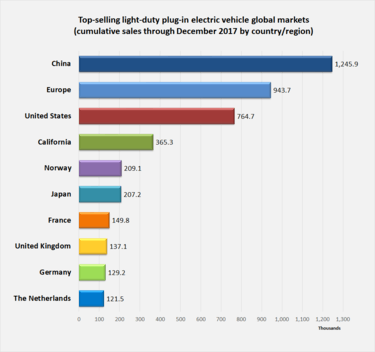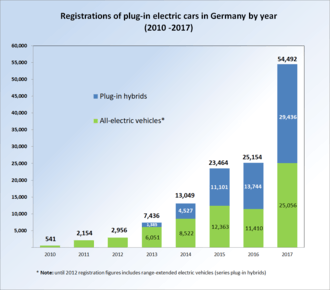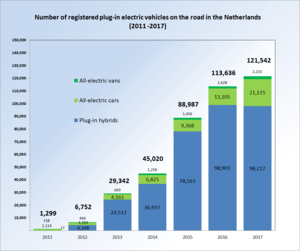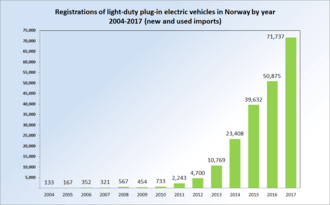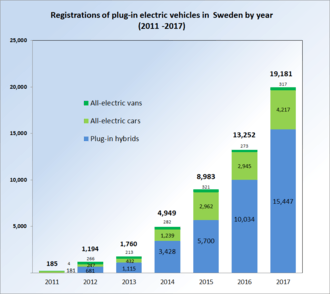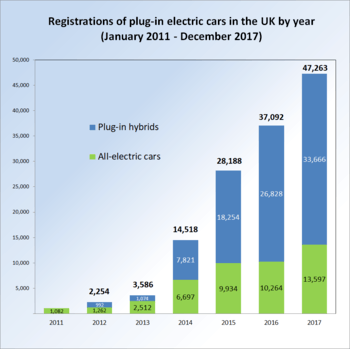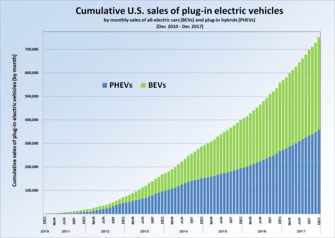Electric car use by country

Electric car use by country varies worldwide, as the adoption of plug-in electric vehicles is affected by consumer demand, market prices and government incentives. Plug-in electric vehicles (PEVs) are generally divided into all-electric or battery electric vehicles (BEVs), that run only on batteries, and plug-in hybrids (PHEVs), that combine battery power with internal combustion engines. The popularity of electric vehicles has been expanding rapidly due to government subsidies, their increased range and lower battery costs, and environmental sensitivity. However, at the end of 2016, the stock of plug-in electric cars represented just a small fraction (0.15%) of the 1.4 billion motor vehicles on the world's roads.[1][3]
Global cumulative sales of highway-legal light-duty plug-in vehicles reached 2 million units at the end of 2016,[1] and the 3 million milestone was achieved in November 2017.[4] Sales of light-duty plug-ins achieved a 1.3% market share of new car sales in 2017, up from 0.86% in 2016, and 0.62% in 2015.[5][6] The global ratio between battery BEVs and PHEVs was 66:34 in 2017,[6] up from 61:39 in 2016,[5] and 59:41 in 2015.[7]
As of December 2017, China had the largest stock of highway legal light-duty plug-ins with over 1.2 million domestically built passenger cars.[1][8][9] China also dominates in plug-in electric bus deployment, with its stock reaching 343,500 units in 2016 out of global stock of about 345,000 vehicles.[2] About 943,600 light-duty passenger plug-ins had been registered in Europe through 2017,[1][10][11] with Norway as the leading market with over 200,000 units.[12] Norway had the highest market penetration per capita in the world in 2016, and 5% of all vehicles on Norwegian roads were plug-ins.[10] Norway also has the world's largest plug-in segment market share of new car sales, 39.2% in 2017.[13] As of December 2017, the United States had about 765,000 plug-in cars,[1][14][15] with California accounting for approximately 48% of cumulative US plug-in sales at over 365,000 units.[10][16] Japan had about 207,200 plug-ins at the end of 2017.[2][17]
History
The global stock of plug-in electric vehicles (PEVs) between 2005 and 2009 consisted exclusively of all-electric cars (BEV), totaling about 1,700 units in 2005, and almost 6,000 in 2009. The plug-in stock rose to about 12,500 units in 2010, of which 350 were plug-in hybrids (PHEVs).[7][18] By comparison, during the Golden Age of the electric car at the beginning of the 20th century, the EV stock peaked at approximately 30,000 vehicles.[19] After the introduction of the Nissan Leaf and the Chevrolet Volt in late December 2010, the first mass-production plug-in electric cars by major manufacturers, plug-in sales grew to about 50,000 units in 2011, to 125,000 in 2012, and almost 213,000 cars and utility vans in 2013. Sales totaled over 315,000 units in 2014, up 48% from 2013.[20] In March 2014, Norway became the first country where over 1 in every 100 passenger cars on the roads was a plug-in.
In five years, global sales of highway legal light-duty plug-in vehicles increased more than ten-fold, totaling more than 565,000 units in 2015 - an 80% increase from 2014, driven mainly by China and Europe.[20] About 775,000 plug-in electric cars and vans were sold in 2016, and 1.22 million in 2017 - up 57% from 2016 - with China accounting for about half of global sales.[1][9][21] The global market share of the new light-duty plug-in segment reached 1.3% in 2017, up from 0.86% in 2016, and 0.38% in 2014.[5][6] Global light-duty plug-in vehicle sales passed the 3 million milestone in November 2017.[4]
| Date | Milestone |
|---|---|
| 1996 | Launch of the limited production General Motors EV1[22] |
| 1997 | Launch of the Toyota RAV4 EV[23] |
| December 2008 | 100th Tesla Roadster delivered[24] |
| December 2010 | Nissan Leaf and Chevrolet Volt deliveries began[25] |
| December 2012 | Annual global sales passed the 100,000 mark[7][20] |
| March 2014 | Norway achieves 1% of cars on the road as plug-ins[26] |
| December 2014 | 100,000th plug-in sold in Japan[7][27] |
| September 2015 | Global plug-in sales passed 1 million units.[28] |
| December 2015 | Annual global sales passed the 500,000 mark[7][20] |
| 3% of passenger cars on Norwegian roads are plug-ins[29] | |
| March 2016 | 500,000th new energy vehicle sold in China[30] (includes heavy-duty commercial vehicles) |
| 200,000th plug-in car sold in California[31] | |
| 100,000th plug-in sold in Norway[32] | |
| May 2016 | Global plug-in sales passed 1.5 million units[33] |
| 500,000th plug-in sold in Europe[34] | |
| August 2016 | 500,000th plug-in sold in the U.S[35] |
| September 2016 | 500,000th new energy passenger car sold in China[36] |
| Global full electric car/van sales passed 1 million.[37] | |
| October 2016 | 100,000th plug-in sold in France[38][39] |
| November 2016 | 100,000th plug-in sold in the Netherlands[40] |
| December 2016 | Global plug-in sales passed 2 million units[1] |
| 5% of passenger cars on Norwegian roads are plug-ins[10] | |
| November 2017 | Global plug-in sales passed 3 million units[4] |
| December 2017 | Annual global sales passed the 1 million unit mark[6][21] |
| Annual global market share passed 1% for the first time[6][21] |
Statistics
| Country | PEV stock(1) | PEV market share | Sales since | ||||
|---|---|---|---|---|---|---|---|
| 2015[41] | 2014[42] | 2013[43] | 2015[41] | 2014[42] | 2013[43] | ||
| ~410,000 | 291,332 | 172,000 | 0.66% | 0.72% | 0.62% | 2008(2) | |
| 258,328 | 83,198[27] | 28,619 | 0.84%[44] | 0.23% | 0.08% | 2008(2) | |
| 126,420[7] | 108,248[27] | 74,124 | n.a. | 1.06% | 0.85% | 2009(3) | |
| 88,991 | 45,020[45] | 28,673 | 9.74% | 3.87% | 5.37% | 2009(3) | |
| 84,401[46][47] | 43,442 | 20,486 | 22.39% | 13.84% | 5.60% | 2003(3) | |
| 74,294 | 43,605(6) | 28,560(6) | 1.2% | 0.70% | 0.65% | 2010(3) | |
| 53,524 | ~24,500[48] | 9,982[48][49] | 1.1% | 0.59%[49] | 0.16%[49] | 2006(3) | |
| 48,669[41][42] | 25,205[50][51] | 12,156[51] | 0.73%[52] | 0.43% | 0.25% | 2006(2) | |
| 17,058[53] | 10,658[54] | 5,596[54] | 0.35%[53] | 0.27%[54] | 0.18%[54] | 2011(2) | |
| 16,996[42][55] | 8,076[56] | 3,138[56] | 2.49%[55] | 1.53%[57] | 0.57% | 2011(3) | |
| Global Total (since 2003) | 1,235,000[41] | 712,000[42] | 405,000[42] | ||||
| Light-duty EV stock and PEV market share of total new car sales in selected regional markets | |||||||
| 425,849[58][59][60] | 233,022[58] | n.a. | 1.41%[59] | 0.66%[61] | 0.49%[62] | 2010(2) | |
| 191,650 | 129,484 | 69,999 | 3.1% | 3.2% | 2.5% | 2010(2) | |
| EV stock for all class segments in China[65][66][67][68][69] | |||||||
| 444,447 | 113,355 | 38,592 | 2011(8) | ||||
| Notes
(1) EV stock only includes cumulative sales or registrations of highway legal light-duty vehicles except where noted. | |||||||
| Country | 2017 | 2016[10][71] | 2015[41][72] | 2014[42] | 2013[73] |
|---|---|---|---|---|---|
| 39.2% | 29.1 % | 22.39 % | 13.84 % | 6.10 % | |
| 14.05% | 4.6% | 2.93% | 2.71% | 0.94% | |
| 5.6% | 0.81% | N/A | N/A | N/A | |
| 5.2% | 3.5% | 2.62% | 1.53% | 0.71% | |
| 2.68% | 1.8 % | N/A | N/A | N/A | |
| 2.6% | 6.7% | 9.9% | 3.87 % | 5.55% | |
| 2.57% | 1.2% | N/A | N/A | N/A | |
| 2.55% | 1.8 % | 1.98 % | 0.75 % | 0.44% | |
| 2.1% | 1.31 % | 0.84 % | 0.23% | 0.08% | |
| 2.06% | 1.6 % | 0.90 % | N/A | N/A | |
| 1.98% | 1.4 % | 1.19 % | 0.70% | 0.83% | |
| 1.86% | 1.37% | 1.07% | 0.59% | 0.16% | |
| 1.13% | 0.90% | 0.66% | 0.72% | 0.60% | |
| 1.1%. | 0.59% | 0.68% | 1.06% | 0.91% | |
| 0.4% | 0.6% | 2.29 % | 0.88% | 0.29% | |
| 0.2% | 0.3% | N/A | 1.57 % | 0.73 % | |
| 4.8% | 3.5% | 3.1% | 3.2% | 2.5% | |
| 1.74% | 1.3% | 1.41% | 0.66% | 0.49% | |
| N/A | 5% | 4.84% | N/A | 0.39% | |
| Notes (1) The French market share corresponds to combined sales BEV passenger cars and utility vans only (PHEVs not included).[70] | |||||
Albania
Albania is considered one of the best countries for emissions for electric cars as it generates all of its electricity from hydroelectric power.[90][91] The use of electric cars, are also used by the Albania Police Force.[92] The Interior Minister claimed, that the cost of fuel per 100 kilometers(62 miles) would cost less than 120 Albanian Leke(less than 1 Euro).[92] Saytaxi is the FIRST EVER taxi company in Albania that offers electric vehicles and operates a fast EV(electric vehicles) charging point, and have been operating in the country since 2014. Its goal is to replace 80% of all non-electric cars with electric in the Taxi-business.[93]
In October 31 2017, Tirana became one of few european countries to use Electric busses when they tested a Solaris Urbino 12, with the purpose of reducing pollution.[94] This was the first Electric bus used for public transport in Tirana and the whole Albania.[94] Tiranas goal is to gradually convert 10 to 20 percent of the bus fleet into electric ones.[94]
Australia
Beginning in mid-2009, a twelve-month field trial was conducted with the Mitsubishi i-MiEV with potential electric vehicle customers, such as government bodies and fleet operators.[95] The iMiEV remained the top selling electric vehicle in Australia through 2013.[96][97] The Mitsubishi Outlander P-HEV, became Australia's top selling EV in 2014[98] and remained the leader into 2016 with 2,015 units sold since its introduction.[99] At the end of March 2015, Tesla Model S registrations totaled 119 in New South Wales and 54 in Victoria. Although no sales figures were reported for Tesla in other states, the combined sales of these two were enough for the Model S to rank as the top selling BEV car for the first quarter of 2015, ahead of the BMW i3 (46) and the Nissan Leaf (31).[100] As of December 2016, about 1,000 Leafs had been sold since its 2012 introduction .[101]
Chargepoint is the only major operator of a charging network in Australia.[102]
Belgium
Sales of electric cars rose from 97 units in 2009, to 116 in 2010, 425 in 2011, to 900 in 2012. Of the latter, only 350 units were sold to individuals.[103]
The Belgian government established purchase incentives for BEVs, ending in 2012.[104] Hybrids were not eligible.[105][106][107] A separate subsidy supported investments in public charging stations.[105]
Brazil

As of September 2015, 2,214 hybrid and electric vehicles were registered in the state of São Paulo[108] In March 2013, the first two Leafs were deployed in Rio de Janeiro to operate as taxis.[109] In September 2014 the BMW i3 became the first EV available for retail customers. As of June 2016, other retail plug-ins were the BMW i8 and the Mitsubishi Outlander P-HEV.[110]
Plug-ins and hybrids are subject to taxes adding up to more than 120% of the retail price.[111][112][113]
In May 2014 São Paulo City passed a municipal law to exempt EV, hybrids and fuel cell vehicles from the city's driving restriction scheme and purchase incentives.[114][108]
In April 2018, BYD receives the largest Brazilian order from the city of São José dos Campos for 29 BYD e5 BEVs and one BYD e6, which will be used by the police and government.[115]
Bulgaria
There were 560 electric motobikes and 520 electric cars officially registered in Bulgaria at the end of March 2018 [116]. The government does not provide grants for buying electric cars, but at least it does not apply road tax to them. Parking electric vehicles in central urban parking zones is free of charge as well.
The first car sharing company in Bulgaria Spark.bg uses only electric cars, mostly Volkswagen_Up#E-up!s and in early 2018 had at least 60 electric vehicles and expected to have 100 at the end of the year. Courier company Speedy uses 20 electric Renault Kangoo.
Canada
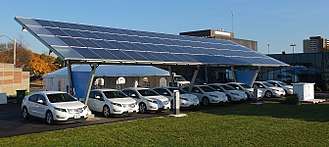
Cumulative sales of EVs in Canada passed 47,800 units in December 2017 and accounted for 1.4% of all new car sales for December 2017, and 0.9% for 2017. [117]The Chevrolet Volt was the top selling PHEV, with cumulative sales of 13,619 units through Dec 2017, and the Tesla Model S was the top selling BEV with 6,731 units sold as of Dec 2017.[117]
An Edmonton, Alberta local ride-sharing company, TappCar, uses a fleet of BYD e6 pure-electric vehicles to serve the Edmonton region and the Edmonton International Airport.[118]
Purchase and other incentives for new EVs are offered by the provinces of Quebec[119][120][121] and British Columbia.[122][123]
In October 2016, Quebec passed legislation that obliges major carmakers to offer an increasing number of PHEV and BEV models, beginning with 3.5% in 2018 and rising to 15.5% in 2020, using a tradable credit system.
China
China is by far the largest electric car market in the world. Domestically built new energy vehicle (NEV) sales totaled 1,728,447 units between January 2011 and December 2017. These figures include heavy-duty commercial vehicles such as buses and sanitation trucks.[8][9][124] Sales of domestically built new energy passenger cars totaled over 1.2 million units between 2011 and 2017, of which, a total of 579,000 were sold in 2017, representing about half of global plug-in car sales in 2017.[7][8][9][125][126][127][128] Domestically-produced vehicles accounted for about 96% of total plug-in electric vehicle sales.[9][129] As of December 2017, the NEV stock consisted of about 1,385,088 all-electric vehicles (80.1%) and 343,359 plug-in hybrid vehicles (19.9%).[9][30][130][131][132][133][134][135] Entry-level vehicles dominate the Chinese plug-in passenger market.[136] The Chinese stock of plug-in electric buses was about 343,500 vehicles as of December 2016, of which, almost 300,000 were BEVs.[2] The Chinese plug-in electric bus stock grew nearly sixfold over 2014, and almost doubled from 2015 to 2016.[2][7]
Chinese sales of domestically-built new energy vehicles in 2017 totaled 777,000 units, up 53% from 2016 consisting of 652,000 all-electric vehicles (up 59.4%) and 125,000 plug-in hybrid vehicles (up 27.6%). Sales of domestically-produced new energy passenger vehicles totaled 579,000 units, consisting of 468,000 all-electric cars and 111,000 plug-in hybrids.[125] Accounting for foreign brands, plug-in car sales rise to about 600,000 in 2017.[9] The plug-in segment achieved a record market share of 2.1% of new car sales.[9]
Three BYD Auto models topped the Chinese ranking of best-selling new energy passenger cars in 2016. The BYD Tang PHEV SUV was the top selling plug-in car (31,405), followed by the BYD Qin (21,868) and the BYD e6 (20,605).[137] Through 2016, the BYD Qin (68,655), remained as the country's all-time top selling plug-in car.[137][138][139][140] BYD Auto was again the world's top selling plug-in manufacturer with over 100,000 units sold in 2016.[1][141] However, in terms of sales revenue, Tesla vehicle sales of US$6.35 billion topped BYD at US$3.88 billion.[142]
The BAIC EC-Series all-electric city car was the Chinese top selling plug-in car with 78,079 units delivered, making the city car the world's top selling plug-in car in 2017. The top selling plug-in hybrid was the BYD Song PHEV with 30,920 units. BYD Auto was the top selling Chinese car manufacturer in 2017.[9]
Government incentives
The Chinese government adopted in 2009 a plan to become one of the world leaders in producing EVs. The plan has four goals: create a world-leading industry; energy security; reduce urban air pollution; and to reduce carbon emissions.[143][144] In June 2012 the State Council published a plan to develop the domestic industry. The plan set a sales target of 500,000 new EVs by 2015 and 5 million by 2020.[145][146] Initial sales were much lower than expected, while most output was purchased for public fleets. New incentives were issued in 2014, with a sales target of 160,000 units for 2014.[147][148] This goal was also not achieved.
The Chinese government uses the term new energy vehicles (NEVs) to designate plug-ins and electrics. Only EVs are eligible for purchase incentives.[149]The Chinese government has put forward the strategy of “Energy Saving and Electric Vehicles”. The policy measures of this strategy mainly focused on carrying out pilots to subsidize EV buyers, promoting charging facilities construction and accelerating EVs commercialization.[150] On June 1, 2010, the government announced a trial program to provide financial incentives in five cities.[151][152] A 2013 joint announcement by the National Development and Reform Commission and finance, science, and industry ministries offered a maximum of US$9,800 toward the purchase of a BEV passenger vehicle and up to US$81,600 for electric buses.[153] In April 2016 the Traffic Management Bureau under the Ministry of Public Security announced special green license plates to facilitate preferential traffic policies.[154]
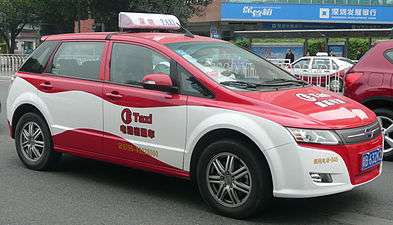 BYD e6 BEV taxi in Shenzhen, China.
BYD e6 BEV taxi in Shenzhen, China.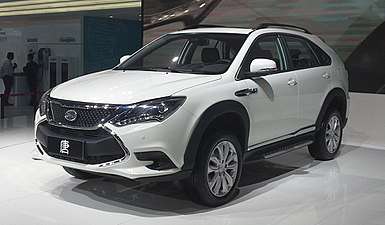
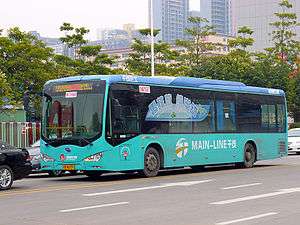
Chile

The Mitsubishi i-MiEV[155][156] was the first EV in Chile. The first public quick charging station was opened in April 2011.[157]
In August 2014 Mitsubishi replaced the i-Miev with the Outlander PHEV. Later that year BMW introduced their "i" range with the i3; Renault launched their Zero Emission (Z.E.) lineup, including the Fluence Z.E. sedan, the Kangoo utility van and Zoe city car. The French brand sold 22 electric vehicles in their first month in the Chilean market.
Colombia
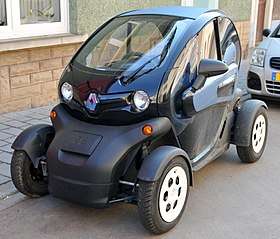
South America's first BEV taxi fleet (made up of BYD e6) was launched at the beginning of 2013 in Bogotá. These taxis were exempted from the driving restriction scheme. The program is an effort to improve air quality and set an example.[158][159][160] In September 2013 45 taxis were delivered. The e6 fleet are part of Colombia's "BIOTAXIS Project."[161] Another three BYD e6s were sent to Colceincias, Bogota's Tech, Science and Innovation Administration.[160]
The BMW i3 was introduced in Colombia in 2014. The BEV Renault Twizy quadracycle was introduced in the Colombian market in June 2015.[162] Sales of the Outlander P-HEV were scheduled to begin in September 2015.[163]
As of June 2015, 126 EVs had been sold, mostly to corporate customers, and consisting of 43 BYD e6s (taxis), 35 Mitsubishi i-MiEVs, 25 BMW i3s, 19 Renault Twizys, and four Nissan Leafs.[163] 203 Twizys had been sold as of October 2015.[164]
In 2013 the government established promotional incentives. These include the exemption from the driving restriction scheme in place in Colombian cities such as Bogotá and Medellín. The government exempted BEV and PHEV cars from import duties for three years, with an annual quota of 750 cars of each type.[163]
Costa Rica
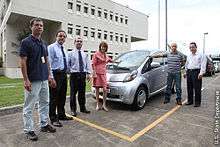
As of January 2015, the Costa Rican stock of electric drive vehicles consisted of 477 hybrid electric vehicles and 2,229 electric vehicles. Plug-in car sales totaled 108 units in 2016.[165] The top selling model was the Outlander P-HEV with 60 units.[165]
In 2006 electric cars were exempted from the consumption tax, while conventional vehicles faced a 30% rate. In October 2012, electric cars were exempted from San José's driving restriction.[166] EVs were exempted from import duties and the government agreed to deploy charging stations in strategic locations in San José.[167]
The first electric car to go on sale was the REVAi, introduced in March 2009. The REVAi, powered by lead–acid batteries, sold 10 units.[168] The Mitsubishi i MiEV was launched in February 2011, with initial availability of 25 to 50 units.[169][170][171]
In January 2013 BYD Auto signed an agreement with the Costa Rican Ministry of Environment and Energy to deploy 200 BYD e6 electric cars for use as "green taxis." Retail sales of the BYD Qin plug-in began in Costa Rica in November.[172][173] Retail sales of the Outlander P-HEV began in March 2015.[174] The BMW i3 was released in September 2016.[175]
Croatia
As of December 2016, 2067 electric cars had been sold in Croatia.[176][177] Of these, 224 were EVs, while the rest were hybrids.[176] As of September 2017, 201 free public charging stations operated in Croatia.[176]
Government incentives
In 2014 and 2015, the Croatian government initiated purchase incentives.[178][179] The subsidies were discontinued in 2016, due to ineffectiveness.[176]
Denmark
As of December 2015, around 4,000 electric cars had been sold in Denmark.[180] Denmark was the second largest European market for light-duty, plug-in commercial vehicles or utility vans, with over 2,600 plug-in vans sold that year, representing 8.5% of all vans sold . Most vans were plug-in hybrids, accounting for almost all EU plug-in van sales.[181] After the expiration of the government incentives, sales drop to about 1,300 all-electric cars in 2016, and fell further in 2017 to almost 700 pure electric cars. As of December 2017, the stock of registered all-electric cars amounted to 8,746 units, slightly up from 8,643 electric cars in 2016. Sales of plug-in hybrids grew from 5 sold in 2013 to 572 in 2016, and 621 units in 2017.[182]
Government incentives
Denmark's sales surged before the expiration of its purchase incentives, and plunged thereafter, its plug-in market penetration plunge to 0.1% as of July 2017.[183] In April 2017 the government announced a partial resumption of the credit,[184] while adding a new fund for fuel cell vehicles.
Estonia
As of February 2015, 1,188 plug-in vehicles were registered.
Estonia was the first country to deploy an EV charging network with nationwide coverage, with fast chargers available along highways at a maximum distance of 40 to 60 km (25 to 37 mi).[185][186] As of December 2012, the nationwide network consisted of 165 fast chargers.[187][188][189]
In 2011, the government confirmed the sale to Mitsubishi of 10 million carbon dioxide credits in exchange for 507 i-MiEV electric cars. The deal included funding 250 fast charging stations and subsidies for the first 500 private buyers of any electric approved by the EU.[190][191] The first 50 i-MiEVs were delivered in October 2011, for use by municipal social workers.[192][193][194][195]
Government incentives
Estonia's figures are low compared to other advanced economies, attributed to lack of government incentives after the carbon credit scheme was exhausted.[196]
Finland
As of October 2016, about 2,250 EVs were registered.[197] Sales reached 854 in the first three quarters of 2016.[198] Plug-in sales were slowed over range concerns and high plug-in prices.[197]
In November 2016, the government set the goal of 250,000 plug-in cars and 50,000 biogas cars on the road by 2030.[197] These goals are part of the Finnish government efforts to comply with the 2015 Paris Agreement.[197]
Manufacturers
Many companies in Finland are involved in next-generation vehicle manufacturing, including Valmet Automotive (Fisker Karma and Garia A/S electric golf cart production)[199] Fortum (concept cars and infrastructure), Kabus[200] (hybrid buses; part of Koiviston Auto Oy), BRP Finland (part of Bombardier Recreational Products), Lynx (snowmobile), Patria (military vehicles), European Batteries[201] (Li-ion battery plant in Varkaus), Finnish Electric Vehicles[202] (battery control systems), ABB, Efore, Vacon (electric motor technology production), Ensto (production of charging units), Elcat (electric vehicle production since the 1980s), production of electric car accessories, Suomen Sähköauto Oy (produces small electric cars), Oy AMC Motors Ltd. (produces and designs small electric cars), Raceabout[203] (specialist electric sport car with very few sales), Gemoto skooters from Cabotec, Resonate's Gemini and Janus Scooters, Moto Bella Oy, Axcomotors, Randax and Visedo.
Research related to electric cars is in progress at the VTT Technical Research Centre of Finland and Tekes.[204]
Electric car organisations in Finland include the Electric Vehicle Association of Finland and Electric Vehicles Finland. A non-commercial electric car conversion organisation is called Electric Cars - Now![205] that converts Toyota Corollas into Li-ion battery-powered electric cars.
Infrastructure
Basic charging infrastructure is available all over Finland, used for winter engine pre-warming. Because of its climate – cold winters and warm summers – Finland is considered a convenient "test laboratory" for electric cars.
France
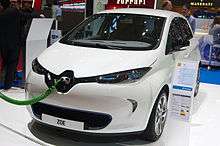
The stock of light-duty plug-in electric vehicles registered in France passed the 100,000 unit milestone in October 2016, making the country the second largest plug-in market in Europe after Norway. It ranked also as the world's fifth largest plug-in market after the U.S., China, Japan and Norway.[38][39]
As of December 2017, a total of 149,797 light-duty plug-in electric vehicles have been registered in France since 2010. The plug-in electric stock consisted of 92,256 all-electric passenger cars, 25,269 all-electric utility vans, and 32,272 plug-in hybrids.[215][82][38] The plug-in passenger car segment achieved a record market share of 1.98% of new car registrations in 2017.[82] France was the largest European market for light-duty electric commercial vehicles or utility vans in 2016.[181]
Plug-in electric car registrations have been led by the Renault Zoe for five years running since 2013, with 5,511 in 2013, 5,970 in 2014, 10,406 in 2015, 11,402 in 2016 and with 15,245 units in 2017, totaling 48,582 units since 2012.[206][82] The electric utility van segment has been led by the Renault Kangoo Z.E. with over 15,000 units sold through September 2016.[38]
In 2008 France established a bonus-malus system offering a purchase incentive for low emission cars and a penalty fee (malus), for the purchase of high-emission vehicles.[216] In 2015 the government introduced an additional bonus for all-electric car purchasers who scrapped a diesel-powered car in circulation before 1 January 2001. As of September 2016, the scrappage bonus had been granted for more than 10,000 purchases.[217]
Germany
As of December 2017, a total of 129,246 plug-in electric cars have been registered in Germany since 2010.[1][222] The country is Europe's largest passenger car market, but ranks only fifth in plug-in car sales in 2016.[34][223] About 80% of the plug-ins registered through September 2016 were registered since 2014.[50][52][224] In 2013 Germany reclassified range-extended vehicles as series plug-in hybrids instead of all-electric vehicles. As a result, the registrations figures for 2012 and older do not account for plug-in hybrids.[225] As of November 2014, the country had 4,800 public charging stations.[226]
A record of 54,492 plug-in cars were registered in 2017, up 217% the previous year, and consisting of 29,436 plug-in hybrids and 25,056 all-electric cars.[222] Registrations achieved a market share of 1.58% in 2017.[222] The top selling models in 2017 were the Audi A3 e-tron (4,454), Renault Zoe (4,322), and BMW i3 (4,319).[227]
Government incentives

Under its National Plattform for Electric Mobility, Chancellor Angela Merkel in 2010 set the goal of putting one million electric vehicles on German roads by 2020.[228][229] Initially, the government did not provide subsidies in favor of research.[228] The Bundestag passed the Electric Mobility Act in March 2015 that authorized local government to grant non-monetary incentives. The measures privilege battery-powered cars, fuel cell vehicles and some PHEVs, by granting local governments the authority to offer additional incentives.[230][231][232][233]
The introduction of the purchase bonus noticeably impacted sales only in September 2016, when registrations grew to 3,061 units.[224]
An incentive scheme was approved in April 2016 including purchase subsidies, charging stations and another federal government fleet purchases, with a target of 400,000 electric vehicles. Premium cars, such as the Tesla Model S and BMW i8, were not eligible.[234][235][236]
As of September 2016, BMW, Citroën, Daimler, Ford, Hyundai, Kia, Mitsubishi, Nissan, Peugeot, Renault, Toyota, Volkswagen, and Volvo had signed up to participate in the scheme.[237][238] The online application system to claim the bonus went into effect on 2 July 2016.[239]
Hong Kong
As of December 2017, 10,666 plug in vehicles were registered in Hong Kong[240]. March 2017 saw 2,964 EV's registered in one month before first registration tax exemption was repealed. 2,939 of these cars were Tesla Model S and X.
As of September 2016, 6,298 plug-in vehicles were on the roads in Hong Kong,[241] up from 3,253 in October 2015.[242] The plug-in segment market share achieved 4.8% of new car sales in Hong Kong in 2015.[241]
As of October 2015, more than 1,200 public electric vehicle charging points were available.[242] More than a dozen models were available for retail customers.[242]
Sales of electric cars took off in Hong Kong with the Tesla Model S in 2014.[243][244] The tax waiver made the Model S competitive in the luxury car segment, at about half the price of other high-end models.[243] According to Tesla, as of September 2016, Hong Kong had the world's highest density of Tesla superchargers, giving most Model S owners a supercharger within a 20-minute drive.[245]
The Government offered purchase incentives to consumers, businesses and service providers were available from 2011 to 2017. The Government further allocated HK$180 million for bus companies to purchase 36 electric buses.[242]
Hungary
In November, 2016 1,473 PEVs were registered in Hungary. The Hungarian government introduced its e-mobility plan in March, 2014. The Jedlik plan supported the domestic production of electric vehicles, expanding the necessary infrastructure and promoting the purchase of EVs with public incentives,[246] including 1,5 million HUF, initiated at the end of 2016.
Iceland
The plug-in car segment in Iceland reached 5.37% of all new vehicles registered in 2016, allowing the country to rank second in Europe after Norway that year.[247] Registrations of new plug-in electric cars totaled 2,990 units in 2017, up 157% from the previous year. The segment's market share achieved a record 14%, globally, second only to Norway.[248] The top selling plug-ins in 2017 were the Mitsubishi Outlander PHEV with 884 units and the Nissan Leaf with 524.[248]
The government eliminated VAT (24%) and CO2-based fees (up to 65%) on new car purchases for EVs.[249]
As of 2017, Orka Náttúrunar (ON) was working to complete a network of 50 kW CCS Combo/CHAdeMO stations along the Ring Road. Iceland remains the only major EV market without a Tesla Supercharger network.[250]
India
As of December 2015, over 6,000 plug-in cars were registered, consisting of 4,350 BEV cars and 1,660 PHEVs.[7] The Indian government has FAME schemes and Lower GST on EVs to encourage electric vehicles. tata also launch electric buses to himachal predesh road transport corparation The Mahindra Reva e2o electric car was introduced in March 2013. It operates on lithium ion batteries with 100 km range for 4 hours of charging. In 2016, a new car, the Mahindra e-Verito, introduced a sedan class Ev at a cost of 9 to 10 lakh Indian rupees ex showroom.
Indonesia
The government supported some trial models made by Tucuxi. Conversion of some vehicles to electric drivetrains was introduced during the APEC Meeting in October 2013.
Ireland
Sales of electric cars in Ireland increased more than four times in 2014 from a low base.[251]
The government committed to making 10% of all vehicles by 2020 (a projected 230,000 vehicles).[252] Government officials reached agreements with French car maker Renault and its partner Nissan. As of September 2014, purchase incentives became available.[253]
Italy
As of December 2015 over 6,100 plug-in cars were registered, consisting of 4,580 BEV cars and 1,550 PHEVs.[7] The top EV in 2015 was the Nissan Leaf (390 units sold).[254]
The government discontinued incentives in 2014 amid a limited public charging infrastructure and tepid reception. Further, many Italian houses were equipped with electric contracts allowing only 3 kW of peak consumption, making home charging of electric cars impractical.[255][256][257]
From January to June 2018, 42,273 plug-in and 2,199 EVs were sold in Italy, a 130% increase compared to 2017.
Japan
As of December 2017, Japan had a stock of light-duty plug-in vehicles of about 207,200.[2][17] Sales totaled 24,660 units in 2015, and 24,851 units in 2016.[2] The segment market share declined from 0.68% in 2014 to 0.59% in 2016.[2] Declining sales growth reflected the governmental and domestic carmaker decision to promote hydrogen fuel cell vehicles instead.[259][260] Sales recovered in 2017, with almost 56,000 plug-in cars sold, and the segment's market share reached 1.1%.[17]
In May 2009 the Japanese Diet passed the "Green Vehicle Purchasing Promotion Measure".[262] The program provided purchasing subsidies for cars, mini and keis, trucks and buses, including an extra subsidy for purchases trading in a sufficiently old used car.[262][263] The program ended on March 31, 2010.[264][265] The Japanese electric vehicle charging infrastructure climbed from 60 public stations in 2010 to 1,381 in 2012.[266]
Mitsubishi introduced multiple plug-in vehicles: the Mitsubishi i MiEV in 2009,[266][267] the Mitsubishi Minicab MiEV in 2011,[268] a truck version of the Minicab MiEV[269] and the Mitsubishi Outlander P-HEV in 2013.[270] As of December 2014, Mitsubishi had sold 36,386 light-duty plug-ins.[268][271]
The Nissan Leaf launched in 2010.[272][273] The Toyota Prius PHEV launched in January 2012, selling 19,100 units through September 2014.[274] Tesla Model S deliveries began in September 2014.[275]
Leaf sales in 2016 were 14,795 units.[258] Nissan had sold 72,494 units cumulatively through 2016, making the Leaf Japan's all-time best-selling plug-in car.[258] Sales of the Outlander PHEV fell sharply from April 2016 as a result of Mitsubishi's fuel mileage scandal.[276] Sales totaled 34,830 units through August 2016.[277]
Kosovo
There have not been much effort in by Kosovo of using Plug-in electric vehicles. However ProCredit Bank, Kosova, became the first institution in Kosovo too use electric vehicles,by buying 10 new Mitsubishi i-MiEV vehicles.[278] In 2017, six teens in the city Gjakova, from BONEVET makerspace, became the first European teenager group to build an electric car out of an Renault Twingo, transforming it from a petrol-fuelled car to a fully functional electric car.[279][280][281][282]
Lithuania
As of the 1st of July 2018 806 EVs were registered. Registrations were led by Nissan (50%). Also 11198 hybrids registered in Lithuania by the 1st of July 2018. Registrations were led by Toyota (64%). Source: https://sumin.lrv.lt/lt/veiklos-sritys/kita-veikla/pletra-ir-inovacijos/elektromobiliu-skaicius-lietuvoje
Mexico
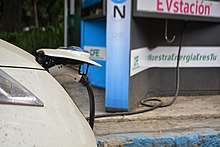
In October 2009 Nissan reached an agreement with the Mexico City government, purchasing 500 Leafs for use of government and corporate fleets. In exchange, recharging infrastructure was to be deployed by the city government.[283][284] The first 100 Leafs (destined for the taxi fleet) were delivered in 2011.[285][286][287]
As of February 2013, about 70 Leafs were deployed as taxis, 50 in Aguascalientes and 20 in Mexico City.[288][289]
Retail Leaf sales began in June 2014.[290] Retail deliveries of the BMW i3 began 2014.[291][292]
The second generation Volt[293] and Tesla Model S began in 2015.[294]
As of October 2012, no government purchase incentives were available. However, electric cars are exempted from Mexico City's driving restriction scheme.[289]
Netherlands
As of 31 December 2017, there were 121,542 highway legal light-duty plug-in electric vehicles registered in the Netherlands, consisting of 98,217 range-extended and plug-in hybrids, 21,115 pure electric cars, and 2,210 all-electric light utility vans. When buses, trucks, motorcycles, quadricycles and tricycles are accounted for, the Dutch plug-in electric-drive fleet climbs to 123,499 units.[79] The country's electric vehicle stock reaches 165,886 units when fuel cell electric vehicles (43), mopeds (4,376), electric bicycles (37,652), and microcars (316) are accounted for.[79] The market was dominated by plug-in hybrids representing 80.8% of the country's stock of passenger plug-in electric cars and vans registered at the end of December 2017.[79]
Plug-in car sales fell sharply during 2016 after changes in the tax rules.[40] Sales during the first half of 2016 were down 64% from the same period in 2015.[298] The plug-in market share declined from 9.9% in 2015, to 6.7% in 2016, and fell to 2.6% in 2017.[79]
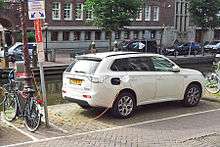
A total of 42,367 plug-in cars were sold in 2015. The top 5 were all plug-in hybrids, led by the Mitsubishi Outlander PHEV. The Tesla Model S continued as the top selling electric car with 1,842 units.[299] A total of 9,185 passenger plug-ins were registered in the first three quarters of 2016. As of December 2016 the Outlander P-HEV was the top-selling plug-in car with 25,984 units, followed by the Volvo V60 PHEV (15,804), Volkswagen Golf GTE (10,691), Volkswagen Passat GTE (7,773), Mercedes-Benz C 350 e (6,226), and the Tesla Model S (6,049).[297]
BYD introduces the first European BYD e6 in Netherlands. BYD and Rotterdam (the second-largest city in the Netherlands) have entered into a binding agreement that calls for BYD to deliver an undisclosed number of its electric e6 crossovers as part of the Netherlands green transportation initiative dubbed "75-EV-RO." [300]
Government incentives

From January 1, 2016, all-electric vehicles continue to pay a 4% registration fee, but for a plug-in hybrids the fee rises from 7% to 15% if its CO2 emissions do not exceed 50 g/km. The rate for a conventional internal combustion car is 25% of its book value.[301][302]
The Dutch government set a target of 15,000 electric vehicles in 2015, 200,000 in 2020 and 1 million in 2025.[295][303] The government exempted selected vehicles from registration fee and road taxes.[304][305][306] The exemption from the registration tax ended in 2013.[307] Battery electric vehicles have special access to parking spaces in Amsterdam, queues for which can otherwise reach up to 10 years.[308] Free charging is offered in public parking spaces.[309]
Other factors contributing to the rapid adoption of plug-in electric vehicles are the Netherlands' small size, which reduces range anxiety; a long tradition of environmental activism; high gasoline prices (US$8.50 per gallon as of January 2013); and some EV leasing programs that provide free or discounted gasoline-powered vehicles for covering long distances.[309]
New Zealand
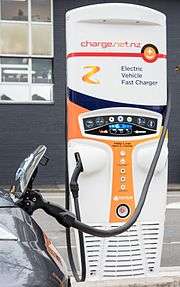
| Type | 2013 | 2014 | 2015 | 2016 | 2017 | 2018 |
|---|---|---|---|---|---|---|
| New PHEVs | 11 | 224 | 451 | 779 | 1,197 | 1,677 |
| New BEVs | 100 | 139 | 206 | 584 | 1,264 | 1,752 |
| Used PHEVs | 0 | 2 | 15 | 116 | 450 | 783 |
| Used BEVs | 42 | 112 | 308 | 996 | 3,214 | 5,434 |
| Total EVs | 153 | 477 | 980 | 2,475 | 6,125 | 9,646 |
As of August 2018, about 9,600 light-duty EVs were registered. The majority of the fleet (5,400) consists of used imports from Japan and the UK. The most popular model by far is the Nissan Leaf, with 4,800 registered.[310]
The New Zealand Government launched an Electric Vehicle Programme in May 2016, in order to encourage EV uptake.[311] Electric vehicles in New Zealand are exempt from road user charges until at least 31 December 2021,[312] and pay the lower petrol rates for ACC levies on motor vehicle licencing.[313]
Norway
The stock of light-duty plug-in electric vehicles registered in Norway totaled more than 200,000 units at the end of 2017.[12] Norway's fleet of electric cars is one of the world's cleanest, because 99% of its power comes from hydropower.[316][317] Norway has the world's largest EV ownership per capita.[318][319][320][321] As of July 2016, 21.5 EVs were registered per 1,000 people.[322][323]
Combined sales of new and used plug-ins captured a market share of 29.1% in 2016,[324] rising to 39.2% in 2017.[13] In January 2017 the electric-drive segment surpassed combined conventional internal combustion engine sales for the first time ever, achieving a combined market share of 51.4% of new car sales.[325][326] Norway was the first country in the world to have all-electric cars top the new car sales monthly ranking.
The Tesla Model S was the top-selling new car four times, and the Nissan Leaf twice.[327]
As of November 2016, the Nissan Leaf was the plug-in car with the most units (19,150).[328] Adding used imports from neighboring countries, 27,115 Leafs were there.[329][328]
Government incentives

Norway offered incentives to help reach the goal of 50,000 zero emission vehicles by 2018. Electrics are exempt from all non-recurring vehicle fees, making electric cars price competitive with conventional cars.[331] BEVs are exempt from the annual road tax, public parking fees and toll payments (including domestic ferries), as well as given access to bus lanes. These incentives were to be in effect until the end of 2017 or until the goal was achieved.[320] PHEVs have a smaller market than BEVs because they are not eligible for the same incentives.[331][332][333] In 2013 the government reduced taxes for to improve PHEV sales.[333][334]
The 50,000 vehicle target was reached on 20 April 2015 at[330][335] a cost of up to 4 billion krone (around US$640 million).[336]
The Government decided to continue the incentives through 2017, although the Parliament phased out some of the incentives.[337][338]
In 2016, the government proposed its National Transport Plan 2018-2029 (NTP) with the goal that all new cars, buses and light commercial vehicles in 2025 should be zero emission vehicles. By 2030, heavy-duty vans, 75% of new long-distance buses, and 50% of new trucks must be zero emission vehicles.[339][340][341]
Pakistan
Pakistan already has a significant market for hybrid vehicles with Honda’s Vezel, Toyota’s Prius and Aqua, and other models seen on the roads. The Automotive Development Policy (2016-2021) and the launch of China-Pakistan Economic Corridor (CPEC) are encouraging foreign investments for the new automobile brands to enter Pakistani market, while the leading manufacturers in the automobile industry in Pakistan are now introducing EV models with a wide range of prices which target consumers of diverse income groups.[343] Several members of the international automobile industry including South Korea, China, and Japan also believe that Pakistan has a high potential market for EV technology, and local businesses are collaborating with them to bring EVs in Pakistan.[344] On January 2017, Dewan Motors with BMW inaugurated Pakistan’s first public charging station for electric and plug-in hybrid electric vehicles in Emporium Mall, Lahore. Dewan Motors had installed another station for plug-in hybrid and electric vehicles at Dolmen Mall in Karachi on February 2017.[345][346]
On 2017, Jolta International had created the first locally manufactured electric motorcycle. The company is based just outside of Bahria Town Rawalpindi, and showcased three Jolta Chargeable Electrical Motorcycles in Gwadar. Leading automobile manufacturers, including Super Power Motorcycles, have started introducing EV models, while Neon, a Pakistan-based motorcycle assembler, has introduced an all electric Neon M3 motorbike in Pakistan. The macho looking sports bike comes with emission free and noiseless features. Neon also assembles Electric scooters in Pakistan.[347]
Philippines
The country's first electric was launched at Silliman University by Insular Technologies in August 2007.[348][349] In some major cities such as Makati, electric Jeepneys are used as well as electric tricycles (rickshaws). The Eagle G-Car is a Philippine BEV car (at a cost as low as $3,000-$6,000).[350] E-Jeepneys were a venture of Renewable Independent Power Producer Inc., which sprang from Greenpeace and other groups, and Solarco, which in turn is a part of GRIPP.[351]
During a demonstration at Nanyang Technological University on February 7, 2018, Nissan Philippines' president and managing director Ramesh Narasimhan has announced that they would like to bring the Leaf to the Filipino market.[352]
Poland
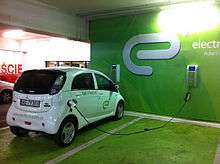
In 2009 Poland began developing charging station infrastructure in Gdańsk, Katowice, Kraków, Mielec and Warsaw with EU funds. In November 2017 an electric car sharing network opened in Wrocław. The fleet is based on 2013 model of Nissan Leaf.
The biggest organization in Poland in the area of electric vehicles is Klaster Green Stream.[354]
The Polish company 3xE - samochody elektryczne (3xE - electric cars) offer electric vehicle conversions of small city cars such as the Smart ForTwo, Citroën C1, Fiat Panda, Peugeot 107, Audi A2.
The converted cars have a range of about 100 km (60 mi), using lithium iron phosphate (LiFePO
4) batteries and brushless DC electric motors.[355]
Portugal
In 2015 the stock of EVs reached about 2,000, consisting of 1,280 BEV cars and 720 PHEVs. EV sales totaled 1,305 units in 2015, up 260% from 2014.
The top selling model was the Mitsubishi Outlander P-HEV (229).[356]
In 2009 Portugal worked with Renault and Nissan to create a national charging network.[357]
In 2010 the government offered purchase incentives for the first 5,000 EVs and a separate scrappage incentive.[358] EVs were exempted from the vehicle registration tax.[107] These incentives were discontinued at the end of 2011.[359]
Romania
As of January 2018 514 EVs were registered. Registrations were led by the BMW i3. The government offered purchase incentives.
Russia
As of July 2016 722 EVs were registered. Registrations were led by the Mitsubishi i-MiEV.[360]
Singapore

As of October 2016, 129 EVs were registered. BMW was the EV segment leader.[241] Adoption was slowed by high purchase prices, lack of public charging infrastructure and unclear national policies. As of October 2016, 74 public charging stations were operating.[241]
The government offered purchase incentives, although the country's taxation scheme made EVs more expensive than a conventional car. EVs face a carbon surcharge and a scrap rebate, along with the annual road tax.[241]
BYD e6 electric taxis operate in Singapore, forming the largest e-taxi fleet in South East Asia. It is operated by HDT Holdings, the only e-taxi operator in Singapore, in collaboration with the ride hailing company Grab.[361]
South Africa
As of December 2015, about 290 plug-in cars were registered, all in 2015.[7] The Nissan Leaf was introduced in October 2013. As of January 2018, this number has increased to 375, 0.2% of all registered vehicles.
GridCars is a Pretoria-based company promoting Commuter Cars, based on the TREV from Australia. The concept is to build ultra-light EVs, lessening demand on battery requirements, and making the vehicle more affordable.[362] The Joule, designed by Cape Town-based Optimal Energy,[363] made its debut at the 2008 Paris Motor Show, with a maximum range of 300 km (190 mi).[364]
The country does not have government incentives or subsidies to promote EVs,[365] although new internal combustion engine vehicles face a surcharge based on engine capacity.[366]
South Korea
| Model | Total Sales 2012–2013 | Sales 2013 | Sales 2012 |
|---|---|---|---|
| Kia Ray EV | 929 | 398 | 531 |
| Samsung SM3 Z.E. | 294 | 277 | 17 |
| Chevrolet Spark EV | 40 | 40 | |
| Total registrations | 1,263 | 715 | 548 |
As of October 2016, about 7,200 plug-in cars had been sold.[7][368] 2,896 EVs were sold during the first ten months of 2016, up 12% year-on-year.[368]
As of 2014, all electric models on sale were manufactured by local firms. The top selling models during 2015 were the Kia Soul EV (657) and the Samsung SM3 Z.E. (640).[369] The Hyundai Ioniq Electric was released in July 2016.[370]
The government offers a purchase subsidy for electric cars. Starting in 2016, the EV purchase tax surcharge was reduced, although EV drivers see various fees.[371]
Spain
The stock of plug-in cars reached almost 6,000 plug-in as of 2015, consisting of 4,460 BEV cars and 1,490 PHEVs.[7] The top selling model in 2015 was the Mitsubishi Outlander P-HEV (389).[376]
3,129 EVs were sold in Spain during the first three quarters of 2016. Sales continued to grow at an accelerated pace, up 79% from the same period in 2015.
In 2011 the national government initiated EV purchase incentives.[377] Aragón, Asturias, Baleares, Madrid, Navarra, Valencia, Castilla-La Mancha, Murcia, Castile and León offered additional incentives.[107]
Sri Lanka
As of September 2015, 2,072 electric cars had been registered, led by the Nissan Leaf. EV sales experienced a record month in September 2015 with 471 units registered, up from only 15 in September 2014.[378]
Sales of the Nissan Leaf began in 2013.[379]
No government incentives promote EVs. Electric vehicle tax increased from 5% to 50% through the new government's Interim Budget.
Sweden
As of December 2017, a total of 50,304 light-duty plug-in vehicles have been registered since 2011, consisting of 36,405 plug-in hybrids, 12,223 all-electric cars, and 1,676 all-electric vans.[55][56][57][380][381][382][78] The market is dominated by plug-in hybrids, representing 74.9% of plug-in car registrations through 2017.[55][57][381][382][78] Passenger plug-ins increased their market share to 3.5% in 2016, and achieved a record of 5.2% in 2017.[10][78]
As of December 2017, the Outlander PHEV continues to rank as the all-time top selling plug-in electric car with 9,957 units registered.[383]. As of December 2016, the Renault Kangoo Z.E. continued as the all-time the leader in the commercial utility EV segment with 1,024 units.[55][57][381][382]
Effective January 2012 Sweden offered subsidies for the purchase and operation of 5,000 electric cars and other "super green cars" with low/no carbon emissions.[384][304] The program was belatedly renewed through 2015[56] and again for 2016 with the addition of subsidies for electric buses.[385]
Switzerland
As of April 2016, over 12,000 EVs had been registered since 2012.[34] During the first quarter of 2016, 1,479 EV were registered, consisting of 773 BEV cars (up 37.5% from 1Q 2015), and 706 PHEVs (up 44.1% from 1Q 2015).[386] Registrations of plug-in cars totaled 6,288 units in 2015, up 133.9% from 2,668 in 2014.[387]
Deliveries of the Mitsubishi i MiEV.[388] the Nissan Leaf were launched in 2011.[389][390]
The government offers no subsidies or incentives for purchasing EVs.[391] Cantons can propose special discounts on annual taxes depending on the car's efficiency label and range from 100% rebate (e.g. Solothurn) to 0%.[392]
Taiwan
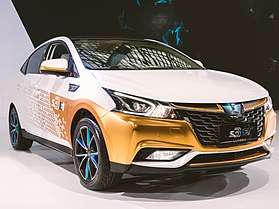
Taiwan has a plan to ban all non-electric vehicles in the coming decades, due to concerns over air quality. The plan calls for all new government vehicles and public buses to be electric by 2030, ban sales of nonelectric motorcycles by 2035, and ban sales of nonelectric four-wheel vehicles by 2040.[393]
The BYD e6 has been used as taxis since the first quarter of 2014.[394]
Thailand
Rizen Energy Co, a subsidiary of Sharich's Holding Co, is the importer and distributor for BYD vehicles in Thailand. This EV brand used to be marketed by Loxley Plc until March 2015.[395]
Ukraine
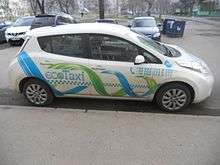
As of 2016, 3,161 EVs and hybrids were registered in Ukraine.[396] Registrations were led by the Nissan Leaf with 647 units.[360]
About 90% of EVs in Ukraine are used imports. During the first eight months of 2016, Ukrainians imported twice as many as in 2015.[397] Imports grew to 1,550 units during the first eight months of 2016.[398]
In August 2016, Ukrainian officials started to refuse the registration of American EVs, citing the need for certification by European rules. To comply with the certification requirements, the cars must be converted from US to European standards, which includes the replacement of a windshield, headlights and other parts, at a substantial cost.[397]
United Kingdom
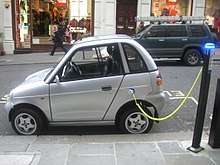
More than 137,000 light-duty plug-in electric vehicles have been registered in the UK up until December 2017, including about 5,100 plug-in commercial vans.[404] As of October 2016, the UK had 11,903 public charging 4,215 stations, of which 696 were rapid chargers.[405]
A total of 36,907 plug-in cars were registered in 2016.[403] Sales of plug-in hybrids more than doubled the sales of all-electric cars.[403][406] The plug-in market share reached 1.37% of new car sales in 2016.[403] While overall new car registrations increased 2.3% from the previous year, plug-in registrations increased 28.6% in 2016.[403] Registrations in 2017 totaled 47,263 plug-in electric cars with a market share of 1.86% of new car sales.[83]
The Mitsubishi Outlander P-HEV is the all-time top selling EV with 26,600 units registered through 2016, accounting for about 50% of all PHEVs sold since 2010.[407][408]
Government incentives
The government offered purchase incentives via the Plug-in Car Grant program beginning in 2011. The program was extended to include vans in February 2012 and in October 2016 to include large electric trucks. As of December 2017, the number of eligible registered plug-in electric cars that have benefited with the subsidy totaled 127,509 units since the launch of the programme in 2011.[83]
In April 2014 and December 2015, the government extended the program with modifications. Eligible ultra-low emission vehicles (ULEVs) included hydrogen fuel cell cars.[409][410][411]
Separately the government subsidized homeowners to install charge points at home via the "Electric Vehicle Homecharge Scheme".[410][411] EVs are exempted from London's congestion charge.[412]
United States
As of December 2017, cumulative sales totaled 764,666 highway legal plug-in electric cars since 2008,[14][15] with 52.9% being all-electric cars (BEVs) and 47.1% plug-in hybrids (PHEVs).[35][15] Cumulative plug-in car sales since 2008 reached 250,000 units in August 2014,[415] and 500,000 in August 2016.[35] California is the largest plug-in car regional market in the country, with over 365,000 plug-in electric vehicles registered through 2017,[10][16] and accounted for approximately 48% of cumulative plug-in sales in the American market from 2011 to June 2016. The other nine states that follow California's Zero Emission Vehicle (ZEV) regulations accounted for another 10%.[416]

A total 157,181 plug-in cars were sold nationwide in 2016, up 37.6% from 2015,[417] and 194,479 in 2017, up 23.7% from 2016.[15] The plug-in segment passed the 1% market share for the first time in 2017, with 1.13% of the country's total new car sales, up from 0.90% in 2016.[15][417]
As of December 2017, the Chevrolet Volt is the all-time best selling plug-in car with 133,838 units, followed by the Tesla Model S with 118,817, and the Nissan Leaf with 114,827 units.[15][14] Sales in 2017 were led by the Tesla Model S with about 26,500 units, the top selling plug-in car for the third year running, followed by the Chevrolet Bolt (23,297), Tesla Model X (~21,700), Toyota Prius Prime (20,936), and the Chevrolet Volt (20,349), together accounting for 58% of total sales in 2017.[15][418]
Government incentives
California established a program to reduce air pollution in the 1980s. Under pressure from manufacturers, the program was revised to offer only modest support of zero-emission vehicles to promote research and development, and greater support for partial zero-emissions vehicles (PZEVs). Many manufacturers then terminated their electric car programs.[419]
The federal tax credit for new plug-in electric vehicles (PEVs) is worth between US$2,500 and US$7,500 depending on battery capacity.[420][420] Several states have established additional incentives. The government pledged US$2.4 billion in federal grants to support the development of next-generation transport, and US$115 million for the installation of charging infrastructure.
See also
- Battery electric vehicle
- Electric car
- Electric vehicle
- Government incentives for plug-in electric vehicles
- List of modern production plug-in electric vehicles
- Electric vehicle industry in India
- Neighborhood electric vehicle
- Plug-in electric vehicle
- Plug-in electric vehicles in Europe
- Renewable energy by country
References
- 1 2 3 4 5 6 7 8 9 10 Cobb, Jeff (2017-01-16). "The World Just Bought Its Two-Millionth Plug-in Car". HybridCars.com. Retrieved 2017-01-17. An estimated 2,032,000 highway-legal plug-in passenger cars and vans have been sold worldwide at the end of 2016. The top selling markets are China (645,708 new energy cars, including imports), Europe (638,000 EVs), and the United States (570,187 plug-in cars). The top European country markets are Norway (135,276), the Netherlands (113,636), France (108,065), and the UK (91,000). Total Chinese sales of domestically produced new energy vehicles, including buses and truck, totaled 951,447 vehicles. China was the top selling EV market in 2016, and also has the world's largest stock of plug-in cars.
- 1 2 3 4 5 6 7 8 9 10 11 International Energy Agency (IEA), Clean Energy Ministerial, and Electric Vehicles Initiative (EVI) (June 2017). "Global EV Outlook 2017: Two million and counting" (PDF). IEA Publications. Retrieved 2018-01-20. See pp. 5–7, 12–22, 27–28, and Statistical annex, pp. 49–51.
- ↑ Edelstein, Stephen (2018-01-04). "Global Electric-Car And Plug-In Hybrid Sales Surpassed 1 Million In 2017, Report Says". TheDrive.com. Retrieved 2018-02-17.
- 1 2 3 Vaughan, Adam (2017-12-25). "Electric and plug-in hybrid cars whiz past 3m mark worldwide". The Guardian. Retrieved 2018-01-20. "The number of fully electric and plug-in hybrid cars on the world’s roads passed the 3 million mark in November 2017."
- 1 2 3 Staff (February 2017). "Global Plug-in Sales for 2016". EV-Volumes.com. Retrieved 2017-02-05.
- 1 2 3 4 5 6 Staff (January 2018). "Global Plug-in Sales for 2017-Q4 and the Full Year (prelim.)". EVvolumes.com. Retrieved 2018-02-17. Global registrations totaled around 1.2 million units in 2017, 57 % higher than 2016. These include all global BEV and PHEV passenger cars sales, light trucks in USA/Canada and light commercial vehicle in Europe. In 2017, 66 % of sales were pure electric (BEV) and 34 % were plug-in hybrids (PHEV). The segment market share was 1.3%, and in December the global plug-in share touched the 2 % mark for the first time.
- 1 2 3 4 5 6 7 8 9 10 11 12 13 International Energy Agency (IEA), Clean Energy Ministerial, and Electric Vehicles Initiative (EVI) (May 2016). "Global EV Outlook 2016: Beyond one million electric cars" (PDF). IEA Publications. Retrieved 2016-08-24. See pp. 4-5, and 24-25 and Statistical annex, pp. 34-37.
- 1 2 3 Cobb, Jeff (2016-12-27). "China Takes Lead As Number One In Plug-in Vehicle Sales". HybridCars.com. Retrieved 2017-01-06. As of November 2016, cumulative sales of plug-in vehicles in China totaled 846,447 units, including passenger and commercial vehicles, making it the world's leader in overall plug-in vehicle sales. With cumulative sales of about 600,000 passenger plug-ins through November 2016, China is also the global leader in the passenger plug-in car segment, ahead of Europe and the U.S.
- 1 2 3 4 5 6 7 8 9 10 Jose Pontes (2018-01-18). "China December 2017". EV Sales. Retrieved 2018-01-19. Sales of plug-in electric cars in China, including imports, totaled 600,174 units in 2017. The BAIC EC-Series was the top selling plug-in with 78,079 units sold in China, making the city car the world's top selling plug-in car in 2017. The top selling plug-in hybrid was the BYD Song PHEV with 30,920 units. BYD Auto was the top selling car manufacturer. Foreign brands captured only about 4% of plug-in sales in 2017, with about half by Tesla. The Chinese plug-in car market represented roughly half of the 1.2 million plug-ins sold worldwide in 2017.
- 1 2 3 4 5 6 7 8 Cobb, Jeff (2017-01-17). "Top 10 Plug-in Vehicle Adopting Countries of 2016". HybridCars.com. Retrieved 2017-01-23.
- ↑ Jose, Pontes (2018-01-28). "Europe December 2017". EVSales.com. Retrieved 2018-02-17. "European sales totaled 306,143 plug-in cars in 2017."
- 1 2 Ayre, James (2018-01-04). "Over 50% Of New Car Registrations In Norway In 2017 = Plug-In Vehicles Or Hybrids". CleanTechnica.com. Retrieved 2018-01-11.
There are now more than 140,000 fully electric cars (BEVs) on Norwegian roads. When plug-in hybrids (PHEVs) are added, the number of electric cars surpasses 200,000.
- 1 2 3 4 Opplysningsrådet for Veitrafikken AS (OFV). "Bilsalget i 2017" [Car sales in 2017] (in Norwegian). OFV. Retrieved 2018-01-11. A total of 71,737 plug-in electric vehicles were registered in Norway in 2017, consisting of: 33,025 new electric cars, 8,558 used imported all-electric cars, 29,236 new plug-in hybrid cars, 742 new all-electric vans, and 176 used imported all-electric vans.
- 1 2 3 Cobb, Jeff (2017-01-11). "America's Plug-in Car Sales Were Their Best Ever in 2016". HybridCars.com and Baum & Associates. Retrieved 2017-01-12. plug-in car sales in the U.S. totaled 157,181 units, up 37.6% from 2015 (114,248). The EV segment achieved an all-time high market share of 0.90% of new car sales in 2016. December sales totaled a record monthly volume of 23,288 units and also achieved a record monthly market share of 1.39% of new car sales. The top selling model for the second year in a row was the Tesla Model S with 29,156 units sold in 2016, followed by the Chevrolet Volt (24,739), Tesla Model X (18,028), Ford Energi Fusion with 15,938, and the Nissan Leaf with 14,006 units. As of December 2016, cumulative sales totaled 570,187 plug-in cars since 2008, with the Chevrolet Volt as the all-time best selling EV with 113,489 units. The Tesla Model S ranks third with an estimated 92,317 units since its inception in 2012.
- 1 2 3 4 5 6 7 8 Cobb, Jeff (2018-01-04). "December 2017 Dashboard". HybridCars.com and Baum & Associates. Retrieved 2018-01-21. Plug-in electric car sales in the U.S. totaled 194,479 units in 2017, consisting of 104,487 all-electric cars and 89,992 plug-in hybrids. The plug-in car segment achieved a market share of 1.13% of new car sales.
- 1 2 3 California New Car Dealers Association (CNCDA) (February 2018). "New Vehicle Registrations in State Predicted to Exceed 2 Million Units Again in 2018" (PDF). CNCDA. Retrieved 2018-02-17. Registrations through December 2017 since 2013.
- 1 2 3 4 Jose Pontes (2018-02-02). "Japan December 2017". EV Sales. Retrieved 2018-02-17. About 56,000 plug-in electric cars were sold in Japan in 2017.
- ↑ Clark, Pilita; Campbell, Peter (2016-08-31). "Motor Industry: Pressure on the Pump". Financial Times. Retrieved 2016-09-30.
- ↑ Justin Gerdes (2012-05-11). "The Global Electric Vehicle Movement: Best Practices From 16 Cities". Forbes. Retrieved 2014-10-20.
- 1 2 3 4 5 Argonne National Laboratory, United States Department of Energy (2016-03-28). "Fact#918: March 28, 2016 - Global Plug-in Light Vehicles Sales Increased By About 80% in 2015". Office of Energy Efficiency & Renewable Energy. Retrieved 2016-03-29.
- 1 2 3 Jose, Pontes (2018-01-29). "World Top 20 December 2017 (Updated)". EVSales.com. Retrieved 2018-02-17. "Global sales totaled 1,224,103 plug-in cars in 2017, with a market share of over 1%."
- ↑ Quiroga, Tony (August 2009). "Driving the Future". Car and Driver. Hachette Filipacchi Media U.S., Inc. p. 52.
- ↑ Sherry Boschert (2006). PHEVs: The Cars that will Recharge America. New Society Publishers, Gabriola Island, Canada. ISBN 978-0-86571-571-4.
- ↑ "Tesla Motors hands keys to 100th Roadster owner". The Mercury News. 2008-12-10. Retrieved 2016-10-01.
- ↑ Cobb, Jeff (2014-12-10). "Retrospective: Four Years of Nissan Leaf and Chevy Volt". HybridCars.com. Retrieved 2016-10-01.
- ↑ Klippenstein, Matthew (2014-04-08). "One Percent Of Norway's Cars Are Already plug-ins". Green Car Reports. Retrieved 2016-10-31.
- 1 2 3 International Energy Agency, Clean Energy Ministerial, and Electric Vehicles Initiative (EVI) (March 2015). "Global EV Outlook 2015" (PDF). Clean Energy Ministerial. Retrieved 2015-03-14. The EV Outlook 2015 figures include only passenger EVs and SUVs (excludes light-weight utility vehicles) and total sales/registrations figures correspond to the 16 EVI countries, which are estimated to represent 95% of the global PEV stock. As of December 2014, the Japanese stock of EVs totaled 108,241 units, and China had about 36,500 BEV buses.
- ↑ Jeff Cobb (2015-09-16). "One Million Global Plug-In Sales Milestone Reached". HybridCars.com. Retrieved 2015-10-10.
- ↑ Petter Haugneland (2016-02-29). "Nasjonal transportplan: Elbil er klimaløsningen" [National Transport: EV is the climate solution] (in Norwegian). Norsk Elbilforening (Norwegian Electric Vehicle Association). Archived from the original on 2016-03-05. Retrieved 2016-03-04.
- 1 2 Cobb, Jeff (2016-05-11). "China Reports 500,000th Plug-in Vehicle Sold". HybridCars.com. Retrieved 2016-05-12. As of March 2016, a total of 502,572 new energy vehicles have been sold in China since 2011, consisting of 366,219 BEV vehicles (72.9%) and 136,353 PHEVs (27.1%). Sales since 2011 includes heavy-duty commercial vehicles such buses and sanitation trucks, and only accounts for vehicles manufactured in the country.
- ↑ Cobb, Jeff (2016-03-14). "Californians Will Buy 200,000th Plug-in Car By This Month". HybridCars.com. Retrieved 2016-03-15. Sales of plug-in cars in California passed the 200,000 unit milestone in March 2016, representing 47% of the 425,000 plug-in cars sold in the U.S. through February 2016.
- ↑ Cobb, Jeff (2016-05-09). "Norway Is Fourth Country To Register 100,000 Plug-in Cars". HybridCars.com. Retrieved 2016-05-09. As of April 2016, the United States is the leading country market with a stock of about 450,000 highway legal light-duty plug-in vehicles delivered since 2008. China ranks second with around 300,000 units sold since 2011, followed by Japan with about 150,000 plug-in units sold since 2009, both through March 2016. European sales are led by Norway with over 100,000 units registered by the end of April 2016.
- ↑ Cobb, Jeff (2016-06-22). "Global Plug-in Car Sales Cruise Past 1.5 Million". HybridCars.com. Retrieved 2016-06-22.
- 1 2 3 Cobb, Jeff (2016-06-15). "Europe Buys Its 500,000th Plug-in Vehicle". HybridCars.com. Retrieved 2016-06-15. As of May 2016, cumulative sales by country are led by the United States with a stock of more than 460,000 highway legal light-duty plug-in vehicles delivered since 2008. China ranks second with almost 390,000 units sold since 2011. Europe is the largest regional market with more than 500,000 plug-in passenger cars and vans registered through May 2016.
- 1 2 3 4 Cobb, Jeff (2016-09-01). "Americans Buy Their Half-Millionth Plug-in Car". HybridCars.com. Retrieved 2016-09-02. See other figures in graphs.
- ↑ Cobb, Jeff (2016-09-28). "China Buys Half-Millionth Passenger Plug-in Car; On Track To Surpass US". HybridCars.com. Retrieved 2016-09-28. Sales of new energy vehicles totaled 689,447 units between 2011 and August 2016. Cumulative sales of new energy passenger cars totaled 493,290 units between 2010 and August 2016.
- ↑ Shahan, Zachary (2016-11-22). "1 Million Pure EVs Worldwide: EV Revolution Begins!". Clean Technica. Retrieved 2016-11-23.
- 1 2 3 4 Cobb, Jeff (2016-10-10). "France Becomes Fifth Nation To Buy 100,000 Plug-in Vehicles". HybridCars.com. Retrieved 2016-10-10.
- 1 2 Foucaud, Isabelle (2016-10-01). "Plus de 100.000 véhicules électriques circulent aujourd'hui en France" [More than 100,000 electric vehicles currently on the road in France]. Le Figaro (in French). Retrieved 2016-10-10. Environment Minister, Ségolène Royal, announced during the 2016 Paris Motor Show that there are more than 100,000 electric vehicles currently on French roads.
- 1 2 3 Cobb, Jeff (2016-11-17). "The Netherlands Becomes Sixth Country To Buy 100,000 Plug-in Vehicles". HybridCars.com. Retrieved 2016-11-18.
- 1 2 3 4 5 Cobb, Jeff (2016-01-18). "Top Six Plug-in Vehicle Adopting Countries – 2015". HybridCars.com. Retrieved 2016-01-23. About 520,000 highway legal light-duty plug-in vehicles were sold worldwide in 2015, with cumulative global sales reaching 1,235,000. The United States is currently the leading market, with 411,120 units sold since 2008, followed by China, with 258,328 units sold since 2011. Japan ranks third (about 130,000), followed by the Netherlands (88,991), Norway (77,897), France (74,291), and the UK (53,254). Four of these countries achieved a PEV market share over 1% of new car sales in 2015: Norway (22.39%), the Netherlands (9.74%), France (1.2%), and the UK (1.1%)
- 1 2 3 4 5 6 7 8 Jeff Cobb (2015-02-18). "Top 6 Plug-In Vehicle Adopting Countries – 2014". HybridCars.com. Retrieved 2015-02-18.
- 1 2 3 4 Jeff Cobb (2014-01-16). "Top 6 Plug-In Vehicle Adopting Countries". HybridCars.com. Retrieved 2014-01-18.
Over 172,000 highway-capable passenger vehicles have been sold in the U.S. between 2008 and December 2013.
- ↑ Rijksdienst voor Ondernemend Nederland (RVO) (January 2015). "Special: Analyse over 2014" [Special: Analysis of 2014] (PDF) (in Dutch). RVO (Dutch National Office for Enterprising). Retrieved 2015-02-24. See total 2014 registration by type of PEV under the heading "31-12-2014". The market share of the passenger EV segment in 2014 was 3.86% of total new passenger car registrations.
- 1 2 Norwegian Road Federation (OFV) (January 2015). "Bilsalget i 2015" [Car sales in 2015] (in Norwegian). OFV. Archived from the original on 2016-02-09. Retrieved 2016-03-05. Registrations of new plug-in vehicles totaled 25,779 electric cars (zero emission vehicles totaled 25,788 accounting for 9 hydrogen vehicles), 7,964 PHEVs and 712 BEV vans in 2015. In addition, registrations of used imports totaled 5,122 electric cars and 55 electric vans. plug-in vehicle registrations totaled 39,632 units.
- ↑ "Ladbare biler i Norge sep, 2015" [Rechargeable cars in Norway September 2015] (in Norwegian). Grønn bil. October 2015. Archived from the original on 2015-01-17. Retrieved 2015-10-14. Click on the bar graph "Registrerte biler" and select "12 mnd" for registrations for each year. Registrations include new and used imports. Move the mouse over each bar to show the sales split between BEV and PHEVs by year. Registrations totaled 44,769 light-duty EVs at the end of 2014, and 74,282 at the end of September 2015.
- 1 2 Ben Lane (2015-01-12). "UK electric fleet passes 24,500 mark". UK: Next Green Car. Retrieved 2015-01-19.
- 1 2 3 4 5 Society of Motor Manufacturers and Traders(SMMT) (2015-01-07). "December 2014 – EV registrations". SMT. Retrieved 2015-01-08. A total of 14,518 plug-in cars were registered during 2014, consisting of 6,697 BEVs and 7,821 PHEVs, up from 3,586 plug-in cars were registered in 2013. A total of 2,476,435 new cars were registered in 2014.
- 1 2 3 Kraftfahrt-Bundesamtes (KBA) (January 2015). "Neuzulassungsbarometer im Dezember 2014" [New Registrations Barometer December 2014] (in German). KBA. Retrieved 2015-01-27. A total of 13,049 plug-in cars registered in Germany during 2014, consisting of 8,522 BEV cars and 4,527 PHEVs.
- 1 2 3 Henk Bekker (2014-03-29). "2014 Germany: Total Number of Electric Cars". BestSellingCars.com. Retrieved 2014-08-23. Cumulative number of registered electric cars was 12,156 as of January 1, 2014.
- 1 2 3 Kraftfahrt-Bundesamtes (KBA) (January 2016). "Neuzulassungsbarometer im Dezember 2015" [New Registrations Barometer December 2015] (in German). KBA. Retrieved 2015-01-21. A total of 23,464 plug-in cars registered in Germany during 2015, consisting of 12,363 BEV cars and 11,101 PHEVs.
- 1 2 Klippenstein, Matthew (2016-01-20). "plug-in car sales in Canada, December 2015: Tesla Model S-Capades". Green Car Reports. Retrieved 2016-06-19. Estimated sales for Ford Energi models. Tesla Model S, Smart ED and the other figures with yellow background from IHS data.
- 1 2 3 4 Klippenstein, Matthew (2015-02-06). "plug-in car sales in Canada, January 2015". Green Car Reports. Retrieved 2015-02-07. Estimated sales for Ford Energi models. Tesla Model S, Smart ED and the other figures with yellow background from IHS data.
- 1 2 3 4 5 6 Bil Sweden (2016-01-04). "Nyregistreringar december 2015 def" [New Registrations December 2015 (final)] (in Swedish). Bil Sweden. Retrieved 2016-04-15. Download the pdf file "Nyregistreringar december 2015 def" (PressRel1512_def.pdf) See table: Nyregistrerade miljöpersonbilar december 2015. A total of 5,625 PHEVs, 2,962 BEV cars and 321 BEV vans were registered in 2015, for a total of 8,908 light-duty EVs. Passenger car registrations totaled 345,108 units in 2015. Figures for 2014 were revised.
- 1 2 3 4 5 Bil Sweden (2015-10-02). "Urstark bilmarknad under 2014" [Exceptionally strong car market in 2014] (in Swedish). Bil Sweden. Retrieved 2015-02-22. A total of 4,656 super clean cars and 282 BEV vans were registered in Sweden in 2014. Super clean cars are those with carbon dioxide emissions of up to 50 g/km (two Porsche plug-in models, the Panamera S E-Hybrid and the 918 Spyder are not accounted as super clean cars, instead they are accounted with conventional hybrids). In 2011 there were 181 EVs registered, 928 in 2012, 1,546 in 2013 and 4,656 super clean cars were registered during 2014. Since the introduction of the super clean car rebate in January 2012 until December 2014, a total of 7,130 super clean cars have been registered.
- 1 2 3 4 5 6 Bil Sweden (2015-01-02). "Nyregistreringar december 2014 (prel)" [New registrations in December 2014 (preliminar)] (in Swedish). Bil Sweden. Retrieved 2015-01-03. Download file "Nyregistreringar december 2014 (prel)" see tables: "Nyregistrerade supermiljöbilar december 2014" with summary of passenger EV registrations by model for 2013 (revised) and 2014; table "Nyregistrerade eldrivna lätta lastbilar (högst 3,5 ton) per modell:" for plug-in utility vans registrations for the same two years; and table "Nyregistrerade miljöbilar per typ jan-dec 2014" for the distribution of registrations by alternative fuels. A total of 303,866 new passenger vehicles were registered in 2014, and a total of 4,656 super clean cars, resulting in a PEV market share of 1.53% of new car sales.
- 1 2 Roger Schreffler (2015-09-23). "PSA, Toyota Lead Way as European Cars Get Cleaner". Ward's Auto. Retrieved 2015-09-24. Cumulative PHEV and BEV sales in Europe totaled 233,022 units as of December 2014.
- 1 2 3 Automotive Industry Data (AID) (2016-02-15). "PHEVs - Take off or transitory blip?". AID Newsletter. Retrieved 2016-02-19. Market share only includes Western European countries. A total of 95,140 PHEV cars were sold in Europe in 2015.
- ↑ Association Nationale pour le Développement de la Mobilité Electrique - AVERE France (2016-03-24). "Quelle est la place de la France sur le marché européen du véhicule électrique ?" [What is the place of France in the European electric vehicle market] (in French). AVERE. Retrieved 2016-03-27. A total of 97,687 BEV vehicles, including vans, were registered in the European market in 2015, up from 65,199 in 2014 (+49.8%).
- ↑ California New Car Dealers Association (CNCDA) (February 2015). "California Auto Outlook Covering Fourth Quarter 2014: New Light Vehicle Registrations Likely to Exceed 1.9 million units in 2015" (PDF). CNCDA. Retrieved 2015-03-15. Registrations through December 2014 since 2010.
- 1 2 California New Car Dealers Association (CNCDA) (February 2016). "California New Vehicle Registrations Expected to Remain Above 2 Million Units in 2016" (PDF). CNCDA. Retrieved 2016-02-17. Registrations through December 2015 since 2011. Revised figures for 2014.
- 1 2 China Association of Automobile Manufacturers (CAAM) (2015-01-14). "The sales and production of new energy vehicles boomed". CAAM. Retrieved 2015-01-14.
- 1 2 China Association of Automobile Manufacturers (2012-01-16). "5,579 electric cars sold in China in 2011". Wind Energy and Electric Vehicle Review. Retrieved 2014-01-12.
- 1 2 Cars21.com (2013-02-13). "EV sales increase 103.9% in China in 2012- Electric China Weekly No 17". Cars21.com. Retrieved 2014-01-12.
- 1 2 Jiang Xueqing (2014-01-11). "New-energy vehicles 'turning the corner'". China Daily. Retrieved 2014-01-12.
- 1 2 China Association of Automobile Manufacturers (CAAM) (2016-01-20). "New energy vehicles enjoyed a high-speed growth". CAAM. Retrieved 2016-02-08.
- 1 2 Philippe Schwoerer (2015-01-09). "Quel marché espérer en 2015 pour le véhicule électrique ?" [What the market expects in 2015 for the electric vehicle] (in French). Association pour l'Avenir du Véhicule Electrique Méditerranéen (AVEM). Retrieved 2015-02-01. The BMW i3 with range extender is often excluded of the count of BEV cars because in France it is classified and accounted together with conventional hybrids.
- ↑ Jose, Pontes (2017-01-31). "Markets Roundup December 2016 (Special Edition)". EVSales.com. Retrieved 2017-02-08. For countries with top PEV market share in 2016 see "II. Engines of Growth: By EV share - Hong Kong ~5%, Iceland 4.6%, Switzerland 1.8%, Belgium 1.8, and 1.6% Austria.
- ↑ Jose, Pontes (2016-02-03). "Markets Roundup December 2015 (Special Edition)". EVSales.com. Retrieved 2016-02-17. For countries with top PEV market share in 2015 see "Engines of Growth:" Hong Kong 4.84%, Denmark 2.29%, and Switzerland 1.98%.
- 1 2 3 4 5 6 European Alternative Fuels Observatory (eafo) (February 2018). "PEV (M1) market share in Europe". eafo. Retrieved 2018-02-26. The plug-in passenger car market share in Europe was 1.74%, corresponding to 0.93% for plug-in hybrids and 0.81% for all-electric cars. Put the mouse over the bar graph to see market share by year.
- ↑ Jose, Pontes (2016-01-29). "Iceland December 2015". EVSales.com. Retrieved 2016-02-17.
- ↑ http://aca.ad/imaca/informe/informe-imaca-2016.pdf
- 1 2 3 4 5 Bil Sweden (2018-01-08). "Definitiva nyregistreringar under 2017" [Definitive new registrations in 2017] (in Swedish). Bil Sweden. Retrieved 2018-01-31. Download the pdf file "PressRel1712_DEF.pdf" See tables: "Nyregistrerade supermiljöbilar december 2017", "Nyregistrerade miljöbilar per typ december 2017" and "Nyregistrerade eldrivna lätta lastbilar (högst 3,5 ton) per modell" - A total of 19,981 light-duty plug-in vehicles were registered in 2017, consisting of 15,447 plug-in hybrids, 4,217 all-electric cars, and 317 all-electric vans. Passenger car registrations totaled 379,393 units in 2017, of which, the plug-in segment captured a market share of 5.2%. Registrations of super green cars totaled 19,211 units, up from 12,995 in 2016. Table "Nyregistrerade miljöbilar per typ december 2017" reports 2017 figures that do not add up with detailed count in table "Nyregistrerade miljöpersonbilar december 2017" so, plug-in cars figures were taken from the latter.
- 1 2 3 4 5 6 "Statistics Electric Vehicles in the Netherlands" (PDF). Rijksdienst voor Ondernemend Nederland (RVO) - Dutch National Office for Enterprising -. RVO. January 2018. Retrieved 2018-01-16. With a total of 25,134 Mitsubishi Outlander P-HEVs registered by the end of December 2017, the plug-in hybrid is the all-time top selling plug-in electric vehicle in the Netherlands. The Tesla Model S is the best selling all-electric car with 8,028 units registered.
- ↑ Jose Pontes (2015-01-18). "Switzerland December 2014". EVSales.com. Retrieved 2015-03-15.
Switzerland's PEV market shared in 2014 was 0.75% of total new car sales.
- ↑ Statistik Austria (2016-03-16). "Kraftfahrzeuge - Neuzulassungen: Neuzulassungen nach Jahren" [Motor vehicles - registrations: Registrations by year] (in German). Statistik Austria. Retrieved 2016-03-20. Download the file "Kfz-Neuzulassungen Jänner bis Dezember 2015." A total of 2,778 passenger plug-in cars were sold in Austria in 2015 out of 308,555 passenger cars, resulting in a market share of 0.90% (see pp. 78 PDF version).
- 1 2 3 4 5 6 France Mobilité Électrique - AVERE France (2018-01-09). "Près de 31 000 véhicules électriques immatriculés en France en 2017 !" [Nearly 31,000 electric vehicles registered in France in 2017!] (in French). AVERE. Retrieved 2018-01-17. A total of 41,724 light-duty plug-in electric vehicles were registered in France in 2017 consisting of 24,910 all-electric cars, 6,011 electric utility vans and 10,803 plug-in hybrid cars. The plug-in car segment achieved a market share of 1.98% of new car registrations in the country in 2017.
- 1 2 3 4 Society of Motor Manufacturers and Traders (SMMT) (2018-01-05). "December – EV registrations". SMMT. Retrieved 2018-01-11. Registrations in 2017 totaled 47,263 plug-in electric vehicles consisting of 13,597 all-electric cars and 33,6663 plug-in hybrids. Of these, a total of 45,187 cars were eligible for the Plug-in Car Grant. Since its launch in 2011, a total of 127,509 cars eligible for the PICG have been registered through December 2017. A total of 2,540,617 new cars were registered in 2017, resulting in a plug-in electric car market share of 1.86% of new car sales.
- ↑ Cobb, Jeff (2016-01-06). "December 2015 Dashboard". HybridCars.com and Baum & Associates. Retrieved 2016-03-14.
- ↑ Jeff Cobb (2015-01-06). "December 2014 Dashboard". HybridCars.com and Baum & Associates. Retrieved 2015-01-06.
- ↑ Jose Pontes (2015-01-10). "Denmark December 2014". EVSales.com. Retrieved 2015-03-15.
Denmark's PEV market shared in 2014 was 0.88% of total new car sales.
- ↑ California New Car Dealers Association (CNCDA) (February 2017). "State New Vehicle Market Up Slightly in 2016; Similar Outlook for 2017" (PDF). CNCDA. Retrieved 2017-02-24. Registrations through December 2016 since 2012. Revised figures for 2015. The share reached 3.5% in 2016 consisting of 1.6% for PHEVs and 1.9% for BEV cars.
- ↑ LeSage, Jon (2016-02-06). "Renault Zoe Ekes By Mitsubishi Outlander in 2016 European Plug-in Sales". HybridCars.com. Retrieved 2017-02-06.
- 1 2 "EV Sales".
- ↑ "The Most Environmentally Friendly Country for Electric Cars May Surprise You". Inverse. Retrieved 2018-05-18.
- ↑ Coren, Michael J. "The best and worst countries for emissions from electric cars". Quartz. Retrieved 2018-05-18.
- 1 2 "Albanian Police equipped with Electric Cars - DigitalSpoiler". digitalspoiler.com. Retrieved 2018-05-18.
- ↑ "Switching the Fleet to Electric Vehicles - Saytaxi Albania Success Story - White label apps for your taxi or limo company". White label apps for your taxi or limo company. 2017-04-26. Retrieved 2018-05-18.
- 1 2 3 Times, Tirana (2017-10-31). "Tirana conducts tests to launch public transport electric buses". Tirana Times. Retrieved 2018-06-12.
- ↑ "Mitsubishi i-MiEV headed to Australia: becomes country's first manufacturer-produced EV". AutoblogGreen. 2010-06-09. Retrieved 2010-06-19.
- ↑ Jose Pontes (2014-01-18). "Australia December 2013". EVSales.com. Retrieved 2014-01-19.
- ↑ Mat Gasnier (2014-01-16). "Australia Q4 2013: Jeep Grand Cherokee shines". Best Selling Cars Blog. Retrieved 2014-01-19.
- ↑ Pontes, Jose (2015-01-15). "Australia Full Year 2014 (Updated)". EV Sales. Retrieved 2015-01-15. Tesla Model S sales estimate is too low, see next source.
- ↑ "Global Mitsubishi Outlander PHEV Sales Pass the 100,000 Mark" (Press release). UK: Mitsubishi Motors UK. 2016-05-19. Retrieved 2016-05-22. As of March 2016, a total of 65,529 units have been sold in Europe (21,052 in the UK and 44,477 in the rest of Europe), 33,730 in Japan, 2,015 in Australia and 259 in the rest of the world, for a total of 101,533 units sold worldwide.
- ↑ David McCowen (2015-05-26). "Why the Tesla is Australia's best-selling electric car". Drive. Retrieved 2015-07-13.
- ↑ Hallenbeck, Todd (2017-01-06). "Nissan grows a better LEAF". Motoring. Retrieved 2017-01-07.
- ↑ "Electric vehicle charging network by ChargePoint". Chargepoint Australia. Retrieved 2015-01-06.
- ↑ "Voiture électrique : cri d'alarme..." 14 May 2013.
- ↑ Carine Mathieu (2012-10-12). "La voiture électrique ne s'impose toujours pas" [The electric car still is not essential]. L'Echo (in French). Retrieved 2012-11-17.
- 1 2 "Conseil des Ministres : nouvelles mesures éco-fiscales, Press Release" (PDF) (in French). Ministre des Finances. 2009-11-20. Archived from the original (PDF) on 2011-07-06. Retrieved 2010-05-24.
- ↑ "Incitants à l'achat de véhicules électriques en Belgique, Press Release". Going Electric. 2010-02-04. Archived from the original on 2011-10-05. Retrieved 2011-06-11.
- 1 2 3 "Overview of Tax Incentives for Electric Vehicles in the EU" (PDF). European Automobile Manufacturers Association. 2010-04-20. Archived from the original (PDF) on 2011-06-11. Retrieved 2010-05-18.
- 1 2 "Isenção de rodízio vai beneficiar 387 carros elétricos e híbridos em SP" [Driving restriction exemption will benefit 387 electric and hybrid cars]. Estadão de São Paulo (in Portuguese). Universo Online (UOL). 2015-09-14. Retrieved 2015-12-31.
- ↑ Philippe Crowe (2013-03-06). "15 Nissan Leaf For Rio de Janeiro Taxi Duty". HybridCars.com. Retrieved 2013-03-09.
- ↑ Miotto, Rafael (2016-06-17). "Agora o mais econômico do Brasil, Prius confirma vocação para cidade" [Now Brazil's top fuel economy car, the Prius confirms its city vocation]. Globo G1 (in Portuguese). Retrieved 2016-06-21.
- ↑ André Trigueiro; Roberto Kovalick (2013-02-08). "Utilização de carros elétricos cresce lentamente no Brasil" [Electric car use in Brazil is growing slowly]. Jornal da Globo (in Portuguese). Retrieved 2013-02-20.
- ↑ André Trigueiro (2013-02-08). "Falta de incentivo e carga tributária inviabilizam carro elétrico no Brasil" [Lack of incentives and tax burden make unfeasible the electric car in Brazil]. Jornal da Globo (in Portuguese). Retrieved 2013-02-20.
- ↑ Cleide Silva (2014-03-21). "Pacote do governo prevê redução de impostos para carros elétricos" [Government package provides tax breaks for electric cars]. O Estado de S. Paulo (in Portuguese). Retrieved 2014-08-22.
- ↑ Leonardo Felix (2014-09-10). "Elétrico, BMW i3 chega com preço de 9 populares e isenção do rodízio em SP" [BMW i3 electric arrives with price of nine popular cars and exempted from São Paulo's driving restriction]. Universo Online (UOL) (in Portuguese). Retrieved 2014-09-20.
- ↑ Chris Randall (July 29, 2018). "BYD delivers 30 EVs to Brazil". electrive.com.
- ↑ https://opendata.government.bg/dataset/pernctpnpahn-ttttc-meceu-mapt-2018
- 1 2 Schmidt, Eric (2018-02-18). "Electric Vehicle Sales In Canada, 2017". FleetCarma News. Retrieved 2018-02-17.
- ↑ Trevor Robb (March 9, 2018). "TappCar partners with Edmonton airport to bring in fleet of pure-electric vehicles". Edmonton Journal.
- ↑ Eric Loveday (2011-04-11). "Quebec to offer plug-in vehicle rebates of up to C$8,000". AutoblogGreen. Retrieved 2011-06-08.
- ↑ "Running on Green Power! Electric Vehicles: 2011-2020 Québec Action Plan" (PDF). Gouvernement du Québec. 2011. Retrieved 2011-06-08. See Table Box 7 for the rebate details and how it changes by year.
- ↑ Klippenstein, Matthew (2013-11-07). "Will Quebec Join California, Oregon As Electric-Car Pioneers?". Green Car Reports. Retrieved 2016-10-28.
- ↑ "The Clean Energy Vehicle (CEV) Program". LiveSmart BC. 2011-11-05. Retrieved 2011-11-13.
- ↑ "Table 1 –Examples of Clean Energy Vehicles and Incentive Levels" (PDF). LiveSmart BC. Retrieved 2011-11-13.
- 1 2 Liu Wanxiang (2017-01-12). "中汽协:2016年新能源汽车产销量均超50万辆,同比增速约50%" [China Auto Association: 2016 new energy vehicle production and sales were over 500,000, an increase of about 50%] (in Chinese). D1EV.com. Retrieved 2017-01-12. Chinese sales of new energy vehicles in 2016 totaled 507,000, consisting of 409,000 BEV vehicles and 98,000 PHEVs.
- 1 2 3 Automotive News China (2018-01-16). "Electrified vehicle sales surge 53% in 2017". Automotive News China. Retrieved 2018-01-19. Chinese sales of domestically-built new energy vehicles in 2017 totaled 777,000, consisting of 652,000 all-electric vehicles and 125,000 plug-in hybrid vehicles. Sales of domestically-produced new energy passenger vehicles totalled 579,000 units, consisting of 468,000 all-electric cars and 111,000 plug-in hybrids. Only domestically built all-electric vehicles, plug-in hybrids and fuel cell vehicles qualify for government subsidies in China.
- ↑ Liu Wanxiang (2016-12-09). "乘联会:11月新能源乘用车销售4.2万辆 众泰、比亚迪、吉利表现强劲" [By the Automobile Association: November new energy passenger car sales totaled 42,000 units. Zotye, BYD, Geely strong] (in Chinese). D1EV.com. Retrieved 2016-12-17. Sales of new energy passenger cars in China totaled 41,795 units in November 2016, consisting of 26,811 BEV cars and 4,178 PHEVs. Sales of new energy passenger car totaled 282,292 units between January and November 2016, consisting of 208,839 BEV cars and 73,453 PHEVs. BYD Auto sold 8,314 units in November 2016 consisting of 2,069 e6s, 2,113 e5s, 1,578 Tangs, 1,215 Qin EV300s, and 1,118 Qins.
- ↑ Liu Wanxiang (2017-01-11). "乘联会:新能源乘用车2016年销量32万辆 比亚迪\吉利\北汽稳居前三" [By the Federation: new energy passenger car sales in 2016 totaled 320,000 units. BYD, Geely and BAIC were the top three manufacturers] (in Chinese). D1EV.com. Retrieved 2017-01-12. Sales of new energy vehicles in China totaled 320,081 units, consisting of 239,830 BEV cars and 80,251 PHEVss.
- ↑ King, Danny (2016-12-29). "China far ahead of US, Europe in total electric vehicle sales". Autoblog.com. Retrieved 2017-01-09.
Last year, China overtook both the US and Europe in annual sales of electric vehicles and PHEVs. This year, it will move ahead of both the US and Europe in cumulative plug-in vehicle sales.
- ↑ Dune, Michael J. (2016-12-14). "China's Automotive 2030 Blueprint: No. 1 Globally In EVs, Autonomous Cars". Forbes. Retrieved 2016-12-14.
- ↑ Liu Wanxiang (2016-10-12). "中汽协:同比增速放缓 9月新能源汽车销量攀升至4.4万辆" [Automobile Association: slowdown ends, new energy vehicle sales in September rose to 44 000] (in Chinese). D1EV.com. Retrieved 2016-10-12. Sales of new energy vehicles totaled 289,000 units between January and September 2016, consisting of 216,000 BEV vehicles and 73,000 PHEVs. In September, sales totaled 44,000 units, consisting of 35,000 BEV vehicles and 9,000 PHEVs. Total car sales during the first nine months of 2016 totaled 19,360,000 units.
- ↑ Staff (2016-05-11). "中汽协:4月新能源汽车产销同步破3万辆 同比增长近2倍" [Automobile Association: April sales of new energy vehicles sync break 30,000, an increase of nearly 2-fold] (in Chinese). D1EV.com. Retrieved 2016-07-31. Sales of new energy vehicles totaled 31,772 units in April 2016, consisting of 23,908 BEV vehicles and 7,864 PHEVs.
- ↑ China Association of Automobile Manufacturers (CAAM) (2016-06-29). "New energy vehicles kept a high-speed growth". CAAM. Retrieved 2016-07-31. Sales of new energy vehicles totaled 35,000 units in May 2016, consisting of 26,000 BEV vehicles and 9,000 PHEVs.
- ↑ China Association of Automobile Manufacturers (CAAM) (2016-07-22). "New energy vehicles kept a high-speed growth". CAAM. Retrieved 2016-07-31. Sales of new energy vehicles totaled 44,000 units in June 2016, consisting of 34,000 BEV vehicles and 10,000 PHEVs. Cumulative sales of new energy vehicles in China during the first half of 2016 totaled 170,000 units, consisting of 126,000 BEV vehicles and 44,000 PHEVs.
- ↑ China Association of Automobile Manufacturers (CAAM) (2016-08-15). "New energy vehicles kept a high-speed growth". CAAM. Retrieved 2016-10-12. Sales of new energy vehicles totaled 36,000 units in July 2016, consisting of 26,000 BEV vehicles and 10,000 PHEVs.
- ↑ Liu Wanxiang (2016-09-09). "中汽协:8月新能源汽车产量回升至4.2万辆 同比增幅达82%" [August new energy vehicle production rose to 42,000 an increase of 82%] (in Chinese). D1EV.com. Retrieved 2016-10-12. Sales of new energy vehicles totaled 38,000 units in August 2016, consisting of 28,000 BEV vehicles and 10,000 PHEVs.
- ↑ Majeed, Abdul (2016-09-29). "China faces acid test in vehicle emissions". Business Line. Retrieved 2016-09-29.
- 1 2 3 Staff (2017-01-19). "Best-selling China-made EVs in 2016". China Auto Web. Retrieved 2017-01-25. Three BYD Auto models topped the Chinese ranking of best-selling new energy passenger cars in 2016. The BYD Tang SUV was the top selling EV in China in 2016 with 31,405 units sold, followed by the BYD Qin with 21,868 units sold, and ranking third overall in 2016 was the BYD e6 with 20,605 units.
- ↑ Mat Gasnier (2014-01-14). "China December 2013: Focus on the all-new models". Best Selling Cars Blog. Retrieved 2014-01-16.
- ↑ Staff (2015-01-14). "2014 EV Sales Ranking". China Auto Web. Retrieved 2015-01-15.
- ↑ Staff (2016-01-14). "Best-selling Sedan in 2015". China Auto Web. Retrieved 2016-02-08. A total of 31,898 Qins were sold in China in 2015.
- ↑ Jin Peiling (2017-01-10). "谁是2016年电动汽车市场的霸主?" [Who is the dominant electric vehicle market in 2016?] (in Chinese). Daily Observation Car. Archived from the original on 2017-01-16. Retrieved 2017-01-15. BYD sold more than 100,000 new energy passenger cars in China in 2016, about 30,000 more units than Tesla Motors. The BYD Tang was the top selling EV in China in 2016 with 31,405 units delivered.
- ↑ Fehrenbacher, Katie (2017-03-14). "Tesla, BYD Jockey for Electric Car World Domination". Green Tech Media. Retrieved 2017-03-15. Revenue figures from Bloomberg New Energy Finance.
- ↑ Henry Lee; Sabrina Howell; Adam Heal (June 2014). "Leapfrogging or Stalling Out? Electric Vehicles in China". Belfer Center, Harvard Kennedy School. Retrieved 2015-01-18. Download EVS in China (full report). See Table 2: Chinas's EV Sales by Brand, 2011-2013, pp.19.
- ↑ Bradsher, Keith (2009-04-01), China Vies to Be World's Leader in Electric Cars, The New York Times, retrieved 2009-04-05
- ↑ Reuters (2014-03-03). "Chinese cities open up green car markets as government battles pollution". Global Post. Retrieved 2014-03-21.
- ↑ Mike Millikin (2012-07-09). "China publishes plan to boost fuel-efficient and new energy vehicles and domestic auto industry; targeting 500K PHEVs and EVs in 2015, rising to 2M by 2020". Green Car Congress. Retrieved 2014-03-22.
- ↑ Xinhua (2014-02-15). "New energy vehicle sales set at 160,000 for 2014 in China". Want China Times. Archived from the original on 2014-03-22. Retrieved 2014-03-21.
- ↑ Gu Liping (2014-09-07). "China's Jan.-Aug. NEV production up 328 percent". Xinhua. ECNS. Retrieved 2014-09-07.
- ↑ PRTM Management Consultants, Inc (April 2011). "The China New Energy Vehicles Program - Challenges and Opportunities" (PDF). World Bank. Retrieved 2013-04-22. See Acronyms and Key Terms, pp. v
- ↑ Wang, Shanyong; Li, Jun; Zhao, Dingtao (November 2017). "The impact of policy measures on consumer intention to adopt electric vehicles: Evidence from China". Transportation Research Part A: Policy and Practice. 105: 14–26. doi:10.1016/j.tra.2017.08.013.
- ↑ "China Announces Plan to Subsidize EVs and PHEVs in Five Major Cities". Edmunds.com. 2010-06-01. Archived from the original on 2010-06-05. Retrieved 2010-06-14.
- ↑ Motavalli, Jim (2010-06-02). "China to Start Pilot Program, Providing Subsidies for Electric Cars and Hybrids". New York Times. Retrieved 2010-06-02.
- ↑ "China announces new electric car subsidy program". China Economic Review. 2013-09-18. Retrieved 2013-09-18.
- ↑ "New license plates to differentiate new energy vehicles". Xinhua. 2016-04-18. Retrieved 2016-04-19.
- ↑ Alejandro Marimán Ibarra (2011-05-04). "Mitsubishi i-MIEV: Lanzado oficialmente en Chile" (in Spanish). Yahoo Chile. Retrieved 2011-07-21.
- ↑ Roberto Valencia (2011-03-17). "Desde julio se venderá en Chile el primer auto 100% eléctrico". La Nación (Chile) (in Spanish). Archived from the original on 2012-04-06. Retrieved 2011-04-28.
- ↑ "Chile inaugura primera estación de carga para autos eléctricos en Latinoamérica". Caribbean News Digital (in Spanish). 2011-04-21. Retrieved 2011-04-28.
- ↑ "BYD Supplying 46 EV Taxis To Bogota, Colombia". CleanTechnica. 2012-12-14. Retrieved 2013-04-22.
- ↑ "Bogotá Launches BEV Taxi Fleet Using Long-Range BYD e6 Cross-over Sedan". YAHOO FINANCE. 2012-12-11. Retrieved 2013-04-22.
- 1 2 "Bogota Taxi Fleet to Get 46 BYD E6 EVs in 2013". autoevolution. Retrieved 2013-04-22.
- ↑ Mark Kane (2013-09-13). "Thanks to BYD e6, Colombia Now Has the Largest Electric Taxi Fleet in South America". InsideEVs.com. Retrieved 2014-05-24.
- ↑ Claudia Cristina Garcés (2015-06-07). "Twizy, el carro eléctrico de Renault" [Twizy, Renault's electric car] (in Spanish). Portafolio.co. Retrieved 2015-12-04.
- 1 2 3 Daniel Otero Bravo (2015-06-19). "Carros Eléctricos en Colombia: En Carga Lenta" [Electric Cars in Colombia: in Slow Charging]. El Tiempo (in Spanish). Retrieved 2015-12-02.
- ↑ Jose Pontes (2015-11-28). "Markets Roundup October 2015". EVSales.com. Retrieved 2015-12-04.
- 1 2 Jose, Pontes (2017-01-27). "Costa Rica December 2016". EVSales.com. Retrieved 2017-02-13.
- ↑ Camila Salazar (2013-07-06). "Carros híbridos y eléctricos se abren paso en Costa Rica" [Hybrid and electric cars make their way in Costa Rica]. La Nación (San José) (in Spanish). Retrieved 2013-07-06.
- ↑ Daniela Garcia (2013-01-21). "MINAE anuncia convenio para insertar taxis "verdes" en el país" [Ministry of Environment and Energy announces agreement to introduce green taxis] (in Spanish). Costa Rica Hoy. Retrieved 2013-05-01.
- ↑ Alejandro Arley Vargas (2009-04-27). "En mes y medio venden 10 carros eléctricos" [Ten electric cars sold in month and a half]. Al Día (in Spanish). Retrieved 2012-10-26.
- ↑ "Carro 100% eléctrico i-miev ya recorre las calles del país" [i-MiEV 100% electric car is already on the country roads]. La Nación (San José) (in Spanish). Rebeca Madrigal. 2011-02-26. Retrieved 2011-02-26.
- ↑ "i-MiEV Goes on Sale in Costa Rica". Green Car Congress. 2011-02-28. Retrieved 2011-03-02.
- ↑ "Mitsubishi lanza auto eléctrico en Costa Rica" [Mitsubishi launches electric car in Costa Rica]. La Nación (San José) (in Spanish). ACAN-EFE. 2010-12-14. Retrieved 2011-01-12.
- ↑ Beatriz Nuñez. "BYD Presenta su Auto Híbrido Qin" [BYD Presents its Hybrid Car Qin] (in Spanish). Puro Motor. Archived from the original on 2013-12-16. Retrieved 2013-12-16.
- ↑ John Voelcker (2013-12-09). "BYD Qin PHEV Now On Sale In Costa Rica". Green Car Reports. Retrieved 2013-12-16.
- ↑ Cristina Fallas (2015-03-06). "Expomóvil abre una vitrina para exhibir lo nuevo del mercado" [Expomóvil auto show opens a showcase to display what is new in the market]. La Nación (San José) (in Spanish). Retrieved 2015-03-09.
- ↑ Herrera, Walter (2016-06-02). "BMW presenta su primer vehículo eléctrico en el país" [BMW presents its first electric vehicle in the country]. La República (in Spanish). Retrieved 2016-09-24.
- 1 2 3 4 "Ponovo kreću subvencije za kupnju električnih vozila". Poslovni dnevnik (in Croatian). 13 September 2017. Retrieved 2017-09-13.
- ↑ "Registered road vehicles and road traffic accidents, 2016" (Press release). Croatian Bureau of Statistics. 21 April 2017. Retrieved 2017-09-13.
- ↑ "Večernjakova analiza: Isplati li se kupiti električni automobil?". Večernji list (in Croatian). 2 April 2015. Retrieved 2016-03-21.
- ↑ "VELIKA USPOREDNA ANALIZA JUTARNJEG Što se više isplati: klasični ili auto na struju?". Jutarnji list (in Croatian). 1 July 2016. Retrieved 2017-04-04.
- ↑ "Dansk Elbil Alliance - Bestand af elbiler i Danmark". danskelbilalliance.dk. Archived from the original on 2015-10-06.
- 1 2 Fergusson, Malcolm (October 2016). "Electric Vehicles in Europe - 2016: Approaching adolescence" (PDF). Transport & Environment. Retrieved 2016-10-13. See pp. 15-16.
- ↑ De Danske Bilimportører (2018-01-08). "ÅRETS BILSALG 2017" [Car sales 2017] (in Danish). Bilimp. Retrieved 2018-02-13. See sections "Et stort dyk i salg af elbiler" and "Miljøbiler er ikke kun elbiler – hvordan ser fremtiden ud for andre miljøvenlige alternativer?"
- ↑ "European Alternative Fuels Observatory". Retrieved 2017-09-13.
- ↑ Fred Lambert (19 April 2017). "Denmark to relaunch its electric vehicle market with incentives after a year with almost no sales". Electritec.
- ↑ Adam Palin (2013-11-19). "Infrastructure: Shortage of electric points puts the brake on sales". Financial Times. Retrieved 2013-12-28.
- ↑ KredEx (2013-02-20). "Estonia becomes the first in the world to open a nationwide electric vehicle fast-charging network". Estonian World. Retrieved 2013-12-28.
- ↑ Laurent J. Masson (2013-02-22). "Estonia Vies for EV Leadership in Europe". PluginCars.com. Retrieved 2013-02-24.
- ↑ Adam Vaughan (2013-02-20). "Estonia launches national electric car charging network". The Guardian. Retrieved 2013-12-28.
- ↑ Justin Gerdes (2013-02-26). "Estonia Launches Nationwide Electric Vehicle Fast-Charging Network". Forbes. Retrieved 2016-10-31.
- ↑ Tammik, Ott (2011-03-03). "State Buys 507 Electric Cars, Builds Charging Network". ERR.
- ↑ "Estonia will promote the use of electric cars under a Green Investment Scheme". Government of Estonia. 2011-03-03.
- ↑ "Mitsubishi begins delivery of the largest order of i-MiEVs to date; 50 of 507 to Estonian government". Green Car Congress. 2011-10-24. Retrieved 2011-10-26.
- ↑ Ingrid Teesalu (2011-10-14). "One in Four Electric Cars Still Unclaimed". ERR News. Retrieved 2011-10-27.
- ↑ Ingrid Teesalu (2011-08-16). "Municipalities Skeptical About Acquiring Electric Cars". ERR News. Retrieved 2011-10-27.
- ↑ Ingrid Teesalu (2011-09-05). "Municipalities Show Lukewarm Interest in Electric Cars". ERR News. Estonia: ERR. Retrieved 2011-10-27.
- ↑ Tubalkain, Marge (2016-04-01). "Eestis müüdi mullu 34 elektriautot" [34 electric cars were sold in Estonia last year]. Majandus24 (in Estonian). Postimees. Retrieved 2016-04-01.
- 1 2 3 4 Yle (2016-11-20). "Finnish government to kickstart electric car market". Yle. Retrieved 2016-11-26.
- ↑ European Automobile Manufacturers Association (ACEA) (2016-10-28). "New Passenger Car Registrations by Alternative Fuel Type in the European Union – Quarter 3 2016" (PDF). ACEA. Retrieved 2016-11-02. A total of 143,315 new passenger plug-in vehicles were registered in the European Union and two EFTA countries during the first nine months of 2016, consisting of 65,270 BEV cars and 76,037 PHEVs (See tables pp. 2 and 3). Light-duty utility vans are not included.
- ↑ "Valmet Automotive to start production of Think electric car". Metso. 2009-08-27. Archived from the original on 2009-08-30. Retrieved 2009-09-14.
- ↑ "Koiviston Auto". Koiviston Auto.
- ↑ "European Batteries". www.europeanbatteries.com.
- ↑ "Finnish Electric Vehicles".
- ↑ "home - Electric Raceabout". raceabout.fi. Archived from the original on 2010-04-08.
- ↑ Tekes Archived 2010-04-12 at the Wayback Machine.
- ↑ "Electric Cars - Now!". Sähköautot - Nyt!. Retrieved 2009-08-20.
- 1 2 3 Automobile Propre (October 2016). "Chiffres de vente & immatriculations de voitures électriques en France" [Sales figures & electric car registrations in France] (in French). Automobile Propre. Retrieved 2016-10-09. See "Ventes de voitures électriques en 2016, 2015, 2014, 2013, 2012, 2011 and 2010" It shows all electric car registrations between 2010 and 2016.
- ↑ Justin Aschard (2012-11-07). "Novembre 2012 - Ventes de véhicules électriques (CCFA)" [November 2012 - Sales of electric vehicles (CCFA)] (in French). France Mobilité Électrique. Archived from the original on October 14, 2013. Retrieved 2013-02-16. See table Bilan annuel des ventes de véhicules électriques (Annual sales of electric vehicles) for detailed sales by category during 2010 and 2011: a total of 184 electric cars and 796 electric utility vans were registered in 2010, and 2,630 electric cars and 1,682 BEV utility vehicles were registered in 2011.
- ↑ France Mobilité Électrique - AVERE France (2013-01-07). "Bilan des Immatriculations pour l'Année 2012" [Record Registrations for 2012] (in French). AVERE. Archived from the original on October 20, 2013. Retrieved 2013-02-16. A total of 5,663 electric cars and 3,651 electric vans were registered in France in 2012.
- ↑ AVERE-France (2015-01-05). "Le marché du véhicule électrique maintient sa progression en 2014" [The electric vehicle market continues to grow in 2014] (in French). AVERE France. Retrieved 2015-02-02. A total of 10,560 electric cars were registered in 2014, up from 8,779 in 2013. A total of 4,485 BEV utility vehicles were registered in 2014, down from 5,175 in 2013.
- ↑ Michaël Torregrossa (2013-01-15). "Voitures hybrides – Le bilan des immatriculations 2012 en France" [Hybrid Cars - The balance of 2012 registrations in France] (in French). Association pour l'Avenir du Véhicule Electrique Méditerranéen (AVEM). Retrieved 2013-01-15.
- ↑ Michaël Torregrossa (2014-01-19). "Hybride rechargeable – Le marché français stagne en 2013" [Rechargeable hybrids - The French market stagnated in 2013] (in French). Association pour l'Avenir du Véhicule Electrique Méditerranéen (AVEM). Retrieved 2014-01-19.
- ↑ France Mobilité Électrique - AVERE France (2016-01-07). "Immatriculations des voitures électriques : + 62,1% en 2015" [BEV car registrations: + 62.1% in 2015] (in French). AVERE. Retrieved 2016-05-14. A total of 17,779 BEV cars were registered in France in 2015. This figure accounts of 822 BMW i3s, including the model with a range extender.
- ↑ France Mobilité Électrique - AVERE France (2016-01-08). "Immatriculations des hybrides rechargeables : La barre des 5.000 est franchie !" [PHEV registrations: The 5,000 barrier is achieved!] (in French). AVERE. Retrieved 2016-07-03. A total of 5,006 PHEVs were registered in France in 2015, up from 1,527 in 2014.
- ↑ France Mobilité Électrique - AVERE France (2016-01-12). "Immatriculations des utilitaires électriques : + 9,6% en 2015" [BEV utility vehicle registrations: + 9.6% in 2015] (in French). AVERE. Retrieved 2016-05-14. A total of 4,916 BEV utility vans were registered in France in 2015.
- 1 2 France Mobilité Électrique - AVERE France (2017-01-09). "Plus de 27 000 véhicules électriques immatriculés en 2016, après un mois de décembre record" [More than 27,000 electric vehicles registered in 2016, after a record month of December] (in French). AVERE. Retrieved 2017-01-09. A total of 33,774 light-duty plug-in vehicles were registered in France in 2016 consisting of 27,751 BEV cars, 5,556 electric utility vans and 6,467 PHEV cars. The EV segment achieved a market share of 1.40% of new car registrations in the country in 2016.
- ↑ Institute for European Environmental Policy (IEEP) (2014-05-30). "Environmental Tax Reform in Europe: Opportunities for the Future" (PDF). IEEP. Archived from the original (PDF) on 2016-10-09. Retrieved 2016-10-08. See Chapter 3 - Car Registration Tax (‘Bonus-Malus’ system) in France pp. 15-21.
- ↑ Schwoerer, Philippe (2016-10-06). "Les aides pour les 2, 3 et 4 roues électriques en 2017 annoncées par Ségolène Royal" [Subsidy for the two-, three- and four-wheeled electric motorcycles by 2017 announced by Ségolène Royal] (in French). Association pour l'Avenir du Véhicule Electrique Méditerranéen (AVEM). Retrieved 2016-10-08.
- ↑ Kraftfahrt-Bundesamtes (KBA). "Monatliche Neuzulassungen - Neuzulassungsbarometer im Dezember 2013" [Monthly registrations - New registrations Barometer in December 2013] (in German). KBA. Retrieved 2014-09-06. A total of 1,385 PHEVs and 6,051 BEV cars were registered during 2013.
- ↑ Autobild (2012-01-12). "2011 Full Year Best-Selling Electric Cars in Germany in 2011". BestSellingCars.com. Retrieved 2012-10-31. Cumulative number of registered electric cars was 4,541 as of January 1, 2012. BEV car and van registrations in 2010 totaled 541 units and 2,154 in 2011..
- ↑ Kraftfahrt-Bundesamtes (KBA) (2013-01-31). "Neuzulassungen E-Mobilität 2012-Kaum Zuwachs wegen Twizy" [Registrations E-mobility - Low growth due to Twizy]. Auto Bild (in German). Retrieved 2013-02-14. A total of 2,956 BEV cars were registered in Germany during 2012.
- ↑ Kraftfahrt-Bundesamtes (KBA) (January 2017). "Neuzulassungsbarometer im Dezember 2016" [New Registrations Barometer December 2015] (in German). KBA. Retrieved 2017-01-11. A total of 25,154 plug-in cars were registered in Germany in 2016, consisting of 11,410 BEV cars and 13,744 PHEVs.
- 1 2 3 4 Kraftfahrt-Bundesamtes (KBA) (2018-01-12). "Neuzulassungsbarometer im Dezember 2017" [New Registrations Barometer December 2017] (in German). KBA. Retrieved 2018-01-12. A total of 29,436 plug-in hybrids and 25,056 all-electric cars were registered in Germany in 2017.
- 1 2 Kraftfahrt-Bundesamtes (KBA) (October 2016). "Neuzulassungsbarometer im September 2016" [New Registrations Barometer September 2016] (in German). KBA. Retrieved 2016-10-07. A total of 17,074 plug-in cars were registered in Germany between January and September 2016, consisting of 7,678 BEV cars and 9,396 PHEVs.
- ↑ Kraftfahrt-Bundesamtes (KBA). "Monatliche Neuzulassungen - Neuzulassungsbarometer im Juni 2014" [Monthly registrations - New registrations Barometer in June 2014] (in German). KBA. Retrieved 2014-09-06. A total of 1,575 PHEVs and 4,188 electric cars were registered during the first six months of 2014.
- ↑ Brian Parkin; Dorothee Tschampa (2014-12-02). "Merkel Backs Incentives in Push for a Million Electric Cars". Bloomberg Businessweek. Archived from the original on 2014-12-07. Retrieved 2014-12-07.
- ↑ Kraftfahrt-Bundesamt (KBA) (January 2018). "Neuzulassungen von Personenkraftwagen nach Marken und Modellreihen im Dezember 2017 (FZ 10) (XLS, 153 KB, Datei ist nicht barrierefrei)" [New registrations of passenger cars by segments and models in December 2016] (in German). KBA. Retrieved 2018-01-13. Click on the link Neuzulassungen von Personenkraftwagen nach Marken und Modellreihen im Dezember 2017 (FZ 10) (XLS, 153 KB, Datei ist nicht barrierefrei) to download the file with registrations figures.
- 1 2 John Blau (2010-05-03). "Berlin plugs in electric mobility strategy". Deutsche Welle. Retrieved 2014-08-24.
- ↑ Barbara Praetorius (2011). "E-Mobility in Germany: A research agenda for studying the diffusion of innovative mobility concepts" (PDF). ECEEE. Retrieved 2014-08-24.
- ↑ Staff (2014-08-04). "Förderung von Elektroautos kommt ins Rollen" [Promotion of electric cars gets rolling]. KFZ-betrieb (in German). Archived from the original on 2014-08-26. Retrieved 2014-08-24.
- ↑ Faye Sunderland (2014-08-15). "Germany plans new EV incentives to spur uptake". The Green Car Website UK. Retrieved 2014-08-24.
- ↑ Staff (2015-03-06). "Elektromobilitätsgesetz:Bundestag beschließt Vorfahrt für E-Autos" [Electric Mobility Act: Bundestag passes priority for electric cars]. Spiegel Online (in German). Retrieved 2015-03-14.
- ↑ Staff (2015-03-05). "Bundestag will Vorfahrt für E-Autos" [Bundestag wants Priority for electric cars]. KFZ-betrieb (in German). Retrieved 2015-03-14.
- ↑ Cremer, Andreas (2016-04-27). "Germany to launch 1 billion-euro discount scheme for electric car buyers". Reuters. Retrieved 2016-05-14.
- ↑ Agence France-Presse (2016-04-28). "Germany to give €1bn subsidy to boost electric car sales". The Guardian. Retrieved 2016-05-14.
- ↑ Staff (2016-04-27). "Bis zu 4.000 Euro Förderung für Elektroautos" [Up to 4,000 euros in funding for electric cars]. KFZ-betrieb (in German). Archived from the original on 2016-06-16. Retrieved 2016-04-14.
- ↑ "Prämie für E-Autos beschlossenWie komme ich jetzt an den Bonus?" [Premium For Electric Cars Decided, how do I get to the bonus?]. Bild (in German). 2016-05-18. Retrieved 2016-09-25.
- ↑ Bundesamt für Wirtschaft und Ausfuhrkontrolle (BAFA) (2016-09-30). "Elektromobilität (Umweltbonus) Zwischenbilanz zum Antragstand vom 30. September 2016" [Electromobility (Environmental bonus) Interim balance of application as of 30 September 2016] (PDF) (in German). BAFA. Retrieved 2016-10-06.
- ↑ Staff (2016-07-04). "Bislang 175 Anträge für Elektroauto-Prämie" [175 applications for electric car-premium up today]. KFZ-betrieb (in German). Archived from the original on 2016-09-27. Retrieved 2016-09-25.
- ↑ Kutt, Gerhard (Dec 2017). "HK Transport Department Dec 2017: Registration and Licensing of Vehicles by Fuel Type" (PDF).
- 1 2 3 4 5 Seah, Lionel; Tan, Christopher (2016-12-03). "Early adopters of electric cars unfazed by obstacles". The Straits Times. Retrieved 2016-12-03.
According to Land Transport Authority figures, there are just 129 EVs and PHEVs here (as of end October), with BMW accounting for most of these cars. The 129 units translate to a mere 0.02 per cent of Singapore's car population of 601,948.
- 1 2 3 4 Environmental Protection Department (EPD) (October 2015). "Promotion of Electric Vehicles in Hong Kong". EPD. Retrieved 2015-11-28.
- 1 2 Josh Horwitz (2015-11-26). "In Hong Kong's luxury car market, a Tesla is cheap". Quartz (publication). Retrieved 2015-11-28. About 70% of the electric cars in Hong Kong roads by the end of Sept 2016 are Tesla Model S cars (~1,720 units).
- ↑ Eric Loveday (2014-07-30). "Tesla Celebrates First Model S Deliveries In Hong Kong – Video". InsideEVs.com. Retrieved 2014-07-30.
- ↑ Zen Soo (2015-07-02). "Hong Kong now has highest density of Tesla superchargers in the world". South China Morning Post. Retrieved 2015-11-28.
- ↑ "Jedlik Ányos Plan E-mobility concept of the Hungarian Government" (PDF). Retrieved September 2017. Check date values in:
|accessdate=(help) - ↑ "Share of new electric and hybrid cars in Iceland second highest in Europe". Iceland Magazine. Retrieved 2017-09-13.
- 1 2 Jose, Pontes (2018-01-23). "Iceland December 2017". EVSales.com. Retrieved 2018-02-18.
- ↑ Kjartan Kjartansson (2017-09-12). "Kolefnisgjald tvöfaldað til að draga úr losun" (in Icelandic). Vísir.
- ↑ "Tesla Supercharger Map". Tesla Inc. Retrieved 2017-09-24.
- ↑ Michael Sheils McNamee (2015-01-12). "Sales of electric cars in Ireland were up 400% last year*". The Journal. Retrieved 2016-01-23.
- ↑ Ryan, Susan (2012-06-04). "How well is Ireland set up for electric cars?". The Journal. Retrieved 2016-01-23.
- ↑ Cleary, Colin (2014-09-14). "Electric Cars In Ireland: How To Get To The Tipping Point?". Green Car Reports. Retrieved 2016-01-23.
- ↑ "Dati vendite auto elettriche e ibride in Italia 2015". Retrieved 2016-02-27.
- ↑ "Ricarica privata domestica - e-Station". e-Station (in Italian). Retrieved 2017-03-02.
- ↑ "Ricaricare l'auto elettrica in casa - Idee Green". www.ideegreen.it (in Italian). Retrieved 2017-03-02.
- ↑ "Ricarica EV in casa, colonnina o presa domestica? - Idee Green". www.ideegreen.it (in Italian). Retrieved 2017-03-02.
- 1 2 3 Kane, Mark (2017-01-25). "Nissan LEAF Sets Sales Record In Japan For 2016". InsideEVs.com. Retrieved 2017-01-26. A total of 14,795 Leafs were sold in Japan in 2016, and a total of 72,494 units since its inception.
- ↑ Shirouzu, Norihiko; Lienert, Paul (2015-10-28). "Auto power play: Japan's hydrogen car vs China's battery drive". Reuters. Retrieved 2016-06-19.
- ↑ Deign, Jason (2015-02-10). "Japan Makes a Big Bet on the Hydrogen Economy". Green Tech Media. Retrieved 2016-06-19.
- ↑ Jose, Pontes (2016-02-08). "Japan December 2015". EVSales.com. Retrieved 2016-02-25.
- 1 2 "Fact Sheet - Japanese Government Incentives for the Purchase of Environmentally Friendly Vehicles" (PDF). Japan Automobile Manufacturers Association. Archived from the original (PDF) on 2010-12-26. Retrieved 2010-12-24.
- ↑ "The Motor Industry of Japan 2010" (PDF). Japan Automobile Manufacturers Association. Retrieved 2010-12-24. See pages 45–46.
- ↑ "Japan's measures to withstand impact of global crisis on its automotive industry - JAMA shares at the 4th Indonesia International Automotive Conference". News from JAMA Asia. Japan Automobile Manufacturers Association (36). September 2009. Retrieved 2010-06-06.
- ↑ "Sales Promotion Scheme and 2009 Vehicle Sales Forecasts - Japan: Rebate for purchase or replacement with eco-friendly vehicles". Marklines.com. Archived from the original on 2009-04-26. Retrieved 2010-06-06.
- 1 2 Yuri Kageyama (2010-04-01). "Japanese Start Buying Affordable Electric Cars". ABC News. Associated Press. Retrieved 2011-01-12.
- ↑ "Mitsubishi Motors Begins Production of i-MiEV; Targeting 1,400 Units in Fiscal 2009". Green Car Congress. 2009-06-05. Retrieved 2010-04-04.
- 1 2 "三菱 i-MiEVなどの2014年12月度 生産・販売実績" [Mitsubishi i-MiEV production and sales results for December 2014] (in Japanese). Electric Vehicle News. 2015-01-28. Retrieved 2015-02-18.
- ↑ Mark Kane (2013-06-10). "Mitsubishi's BEV Vehicle Sales Tumbling in Japan as Outlander PHEV Dominates". InsideEVs.com. Retrieved 2013-06-16.
- ↑ Jay Cole (2013-01-24). "Mitsubishi Outlander PHEV On Sale In Japan Today, Extended Promotional Video Released". Inside EVs. Retrieved 2013-01-28.
- ↑ Mark Kane (2014-01-14). "Sales Of Mitsubishi MiEV in Japan Fell Off Sharply in 2013; Battery Production Constraints Probable Cause". InsideEVs.com. Retrieved 2014-02-14.
- ↑ "Nissan delivers first Leaf in Japan". The Green Car Website. 2010-12-22. Retrieved 2010-12-23.
- ↑ "Nissan delivers first LEAF cars in Japan". International Business Times. 2010-12-22. Retrieved 2010-12-23.
- ↑ "Toyota Is Global Hybrid Leader With Sales Of 7 Million" (Press release). Torrance, California: PR Newswire. 2014-10-13. Retrieved 2014-10-18.
- ↑ Takashi Mochizuki (2014-09-08). "Tesla's Musk, in Tokyo, Says 'Heart' of Model S Is Japanese". The Wall Street Journal. Retrieved 2014-09-08.
- ↑ Kane, Mark (2016-09-19). "Mitsubishi Outlander PHEV Sales In Japan Down Nearly 90% In July". InsideEVs.com. Retrieved 2016-10-01.
- ↑ "三菱 アイミーブなどの2016年8月度 販売実績" [Mitsubishi i-MiEV production and sales results for August 2016]. Electric Vehicle News (in Japanese). 2016-09-28. Retrieved 2016-10-01. A total of 34,830 Outlander P-HEVs have been sold in Japan through August 2016.
- ↑ Kosova, ProCredit Bank. "ProCredit Bank, the first institution in Kosovo to use electric vehicles - News - ProCredit Bank Kosova". ProCredit Bank Kosova. Retrieved 2018-05-23.
- ↑ "It's electric! Kosovo teens build battery-powered car - Prishtina Insight Prishtina Insight". prishtinainsight.com. Retrieved 2018-05-23.
- ↑ "Kosovo makes it's first electric car - DigitalSpoiler". digitalspoiler.com. Retrieved 2018-05-23.
- ↑ "Kosovo's maker-space is building their own Electric Car - DigitalSpoiler". digitalspoiler.com. Retrieved 2018-05-23.
- ↑ User, Super. "The first electric car in Kosovo". www.youseefor.me. Retrieved 2018-05-23.
- ↑ "Nissan alista puntos de recarga del Leaf" (in Spanish). CNN Expansion. 2010-06-02. Retrieved 2010-09-26.
- ↑ "Nissan aims to bring electric car to Mexico City in 2011". Market Watch. 2009-10-28. Retrieved 2010-09-26.
- ↑ "Nissan entregó los primeros LEAF en México". Univision (in Spanish). 2011-09-28. Retrieved 2011-10-06.
- ↑ Nissan (2011-09-26). "Nissan delivers three of 100 Leaf taxis to government of Mexico City". AutoblogGreen. Retrieved 2011-10-06. See details in Press Release.
- ↑ "Nissan Leaf heading south of the border to Mexico City". AutoblogGreen. 2009-11-03. Retrieved 2010-09-26.
- ↑ Philippe Crowe (2013-02-14). "Mexico's Leaf Taxi Pilot Program Well Received". HybridCars.com. Retrieved 2013-05-14.
- 1 2 "Autos eléctricos, una moda costosa en México" [Electric cars, one costly fashion in Mexico]. Vanguardia (in Spanish). 2012-10-15. Retrieved 2013-05-14.
- ↑ Mike Millikin (2014-06-06). "Nissan launches LEAF sales in Mexico; first company to sell a 100% electric vehicle there". Green Car Congress. Retrieved 2014-06-08.
- ↑ "BMW Group México entrega el primer BMW i3 en el país" [BMW Group Mexico delivers the first BMW i3 in the country] (Press release) (in Spanish). Mexico D.F.: BMW Group. 2014-09-29. Retrieved 2014-10-18.
- ↑ Owner receives the first 2015 BMW i3 in Mexico (2014-10-03). "Propietario recibe el primer BMW i3 2015 en México". Auto Cosmos (in Spanish). Retrieved 2014-10-18.
- ↑ Mark Kane (2015-12-26). "2016 Chevrolet Volt Now On Sale In Mexico". InsideEVs.com. Retrieved 2015-12-26.
- ↑ Mark Kane (2015-12-24). "Tesla Model S Now On Sale In Mexico". InsideEVs.com. Retrieved 2015-12-24. See more details in video (in Spanish).
- 1 2 Rijksdienst voor Ondernemend Nederland (RVO) (January 2014). "Cijfers elektrisch vervoer - Aantal geregistreerde elektrische voertuigen in Nederland - Top 5 geregistreerde modellen elektrische auto (31-12-2013)" [Figures electric transport - Number of registered electric vehicles in Netherlands and Top 5 registered electric vehicle models (12-31-2013)] (PDF) (in Dutch). RVO (Dutch National Office for Enterprising). Archived from the original (PDF) on 2014-05-31. Retrieved 2014-09-17. See under the heading "31-12-2013" for total registrations figures at the end of December 2013.
- ↑ Rijksdienst voor Ondernemend Nederland (RVO) (January 2016). "Cijfers elektrisch vervoer – Aantal geregistreerde elektrische voertuigen in Nederland – Top 5 geregistreerde modellen PHEVe elektrische auto (31-12-2015) – Top 10 geregistreerde modellen volledig elektrische auto (31-12-2015)" [Figures electric transport – Number of registered electric vehicles in Netherlands – Top 5 registered PHEV models (31-12-2015) – Top 10 registered fully electric vehicle models (31-12-2015)] (PDF) (in Dutch). RVO (Dutch National Office for Enterprising). Retrieved 2016-03-13.
- 1 2 3 "Cijfers elektrisch vervoer – Top 5 geregistreerde modellen PHEVe elektrische auto – Top 10 geregistreerde modellen volledig elektrische auto" [Figures electric transport – Top 5 registered PHEVs – Top 10 registered fully electric vehicle models] (PDF). Rijksdienst voor Ondernemend Nederland (RVO) - Dutch National Office for Enterprising - (in Dutch). BovagWebsite. January 2017. Retrieved 2017-01-13. With a total of 25,984 Mitsubishi Outlander P-HEVs registered by the end of December 2016, the PHEV is the all-time top registered plug-in vehicle in the Netherlands.
- ↑ RAI (2016-09-08). "EU-voertuigregistraties alternatieve brandstoffen" [EU - Registrations of vehicles with alternative fuels] (in Dutch). RAI Vereniging. Retrieved 2016-10-14.
- ↑ Priest, Ruben (2016-01-11). "De 5 populairste semi-elektrische en elektrische auto's van 2015" [The 5 most popular PHEVs and BEV cars in 2015] (in Dutch). Groen7.nl. Retrieved 2016-03-13.
- ↑ Eric Loveday (June 1, 2011). "Europe's first BYD e6 shows up in the Netherlands". autoblog.
- ↑ Loveday, Eric (2016-01-23). "Netherlands Shocks With Nearly 16,000 plug-in Car Sales In December!". InsideEVs.com. Retrieved 2016-02-08.
- ↑ Staff (2016-01-01). "Elektrische auto" [Electric car]. Auto & Fiscus (in Dutch). Retrieved 2016-02-08. This page presents the current state of fiscal arrangements for plug-in cars in the Netherlands.
- ↑ Sander van der Kuip (November 2011). "The potential of electric vehicles amongst Dutch lease drivers". Tilburg University. Retrieved 2013-10-11.
- 1 2 "Overview of Purchase and Tax Incentives for Electric Vehicles in the EU" (PDF). European Automobile Manufacturers Association. 2011-03-14. Archived from the original (PDF) on 2011-09-27. Retrieved 2011-07-31.
- ↑ "Leaf prijzen" (in Dutch). Nissan Netherlands. Retrieved 2010-05-19.
- ↑ Sam Abuelsamid (2010-05-17). "Nissan announces European prices for Leaf, under €30,000 after incentives". AutoblogGreen. Retrieved 2010-05-19.
- ↑ Nederlandse Omroep Stichting (NOS) (2013-12-24). "Forse toename elektrische auto's" [Major increase in electric car sales]. NOS (in Dutch). Retrieved 2013-12-26.
- ↑ Graeme Roberts (2010-05-17). "UK: Nissan Leaf costlier in Europe even with incentives". Just-Auto. Retrieved 2010-05-17.
- 1 2 Elisabeth Rosenthal (2013-02-09). "Plugging In, Dutch Put Electric Cars to the Test". The New York Times. Retrieved 2013-02-11.
- 1 2 "Monthly electric and hybrid light vehicle tables". Ministry of Transport New Zealand. Retrieved 2018-04-04.
- ↑ "Electric Vehicles". Ministry of Transport New Zealand. 2016-10-03. Retrieved 2016-10-03.
- ↑ https://www.transport.govt.nz/multi-modal/climatechange/electric-vehicles/
- ↑ https://www.acc.co.nz/about-us/how-levies-work/paying-levies-if-you-own-or-drive-a-vehicle/
- ↑ Staff (2014-01-08). "Over 20.000 ladbare biler på norske veier" [Over 20,000 rechargeable electric cars on Norwegian road] (in Norwegian). Grønn bil. Archived from the original on 2014-01-23. Retrieved 2014-01-13.
- ↑ Norwegian Road Federation (OFV) (January 2017). "Bilsalget i 2016" [Car sales in 2016] (in Norwegian). OFV. Archived from the original on 2017-01-18. Retrieved 2017-01-11. A total of 50,875 plug-in vehicles were registered in Norway in 2016, consisting of: 24,222 new electric cars, 5,281 used imported BEV cars, 20,663 new PHEV cars, 607 new BEV vans, and 102 used imported BEV vans.
- ↑ Figenbaum, Erik; Kolbenstvedt, Marika (June 2016). "Learning from Norwegian Battery Electric and PHEV users". Institute of Transport Economics (TØI), Norwegian Centre for Transport Research. Retrieved 2016-08-17. TØI report 1492/2016. See pp. 1.
- ↑ Alister Doyle; Nerijus Adomaitis (2013-03-13). "Norway shows the way with electric cars, but at what cost?". Reuters. Retrieved 2013-03-15.
- ↑ Joly, David (2015-10-16). "Norway is A Model For Encouraging Electric Car Sales". The New York Times. Retrieved 2016-02-16.
- ↑ Agence France-Presse (2011-05-15). "Electric cars take off in Norway". The Independent. Retrieved 2011-10-09.
- 1 2 European Association for Battery, Hybrid and Fuel Cell Electric Vehicles (AVERE) (2012-09-03). "Norwegian Parliament extends electric car iniatives [sic] until 2018". AVERE. Archived from the original on 2013-10-24. Retrieved 2013-04-10.
- ↑ Ole Henrik Hannisdahl (2012-01-09). "Eventyrlig elbilsalg i 2011" [Adventurous electric vehicle sales in 2011] (in Norwegian). Grønn bil. Archived from the original on 2012-02-07. Retrieved 2012-01-14. See table "Elbilsalg i 2011 fordelt på måned og merke" (Electric vehicle sales in 2011, by onth and brand) to see monthly sales for 2011.
- ↑ Cobb, Jeff (2016-08-09). "California Continues To Pull More Than Its Weight In Plug-in Car Sales". HybridCars.com. Retrieved 2016-08-30. As of July 2016, California's EV concentration was 5.83 registrations per 1,000 people, the U.S. was 1.51 per 1,000. Norway exceeds California by 3.69 times, California narrowly outpaces the Netherlands by 1.04 times.
- ↑ Cobb, Jeff (2016-09-01). "Americans Buy Their Half-Millionth Plug-in Car: Concentration of plug-in electrified car registrations per 1,000 people". HybridCars.com. Retrieved 2016-09-04. As of July 2016, Norway had a concentration of registered plug-in cars per 1,000 people of 21.52, the Netherlands of 5.63, California of 5.83, and the United States national average was 1.52.
- ↑ Norsk Elbilforening (Norwegian Electric Vehicle Association) (2017-01-05). "Elbilsalget: Ned i fjor – venter ny vekst i år" [EV Sales: Down from last year - awaiting new growth this year] (in Norwegian). Norsk Elbilforening. Retrieved 2017-01-21.
- ↑ Moberg, Knut (2017-02-06). "Bilsalget i januar 2017 - BMW foran Toyota" [Car sales in January 2017 - BMW surpassed Toyota]. Dinside.no (in Norwegian). Retrieved 2017-02-10.
- ↑ Cobb, Jeff (2016-10-11). "Almost Half The Cars Bought In Norway Last Month Were Electrified". HybridCars.com. Retrieved 2016-10-11.
- 1 2 Cobb, Jeff (2016-12-12). "Chevy Volt and Nissan Leaf Celebrate Their Sixth-Year Anniversary". HybridCars.com. Retrieved 2016-12-14.
- ↑ Valle, Marius (2016-12-12). "Disse elbilene er det flest av i Norge" [These electric cars are the majority in Norway]. Teknisk Ukeblad (TU) (in Norwegian). Retrieved 2016-12-15.
- 1 2 Jeff Cobb (2015-04-20). "Norway Celebrates 50,000th Plug-in Car Sold; Will EV Incentives Continue?". HybridCars.com. Retrieved 2015-04-20.
- 1 2 Lars Ole Valøen. "Electric Vehicle Policies in Norway" (PDF). Archived from the original (PDF) on 2012-03-02. Retrieved 2012-10-24.
- ↑ Norsk Elbilforening (October 2012). "The Norwegian Electric Vehicle Association". Norsk Elbilforening (Norwegian Electric Vehicle Association). Archived from the original on 2012-10-11. Retrieved 2012-10-24.
- 1 2 "Fortsatt godt elbilsalg i mai" [Still good EV sales in May] (in Norwegian). Grønn bil. 2013-06-05. Archived from the original on 2013-08-07. Retrieved 2013-06-06.
- ↑ "Billigere PHEVer fra 1.juli" [Cheaper PHEVs from 1 July] (in Norwegian). Grønn bil. 2013-06-05. Archived from the original on 2013-08-07. Retrieved 2013-06-06.
- ↑ Petter Haugneland (2015-04-20). "50.000 elbiler på norske veier!" [50,000 electric cars on Norwegian roads!] (in Norwegian). Norsk elbilforening (Norwegian Electric Vehicle Association). Archived from the original on 2015-04-25. Retrieved 2015-04-21.
- ↑ Kristoffer Thoner; Robin Krüger (2015-02-26). "Fredningstiden for elbilene snart over" [Close season for electric cars will be over soon]. TV2 (in Norwegian). Retrieved 2015-03-15.
- ↑ "Norway to slash electric car perks because it's costing government too much money". Agence France-Presse. 2015-05-07. Retrieved 2016-03-06.
- ↑ "Samarbeidspartiene enige om bilavgifter" [Cooperative parties agreed vehicle taxes]. Dagens Næringsliv (in Norwegian). 2015-05-06. Retrieved 2016-03-06.
- ↑ Blaker, Magnus (2016-02-29). "NTP: Nå kommer elbil-bakrusen" [NTP: Now Comes EV Hangover] (in Norwegian). Side3.no. Retrieved 2016-03-06.
- ↑ "NTP: Klimautslippene må kuttes" [NTP: Greenhouse gas emissions must be cut] (in Norwegian). Norwegian Coastal Administration. 2016-02-29. Retrieved 2016-03-06.
- ↑ Cobb, Jeff (2016-03-08). "Norway Aiming For 100-Percent Zero Emission Vehicle Sales By 2025". HybridCars.com. Retrieved 2016-03-09. More than 90,000 light-duty vehicles are registered in Norway as of February 2016.
- ↑ Karakoram Motors
- ↑ "Future of Electric Vehicles in Pakistan". Techjuice. Retrieved 1 September 2018.
- ↑ "Future of Electric Vehicles in Pakistan". PAGE. Retrieved 1 September 2018.
- ↑ "Dewan Motors installs first BMW public charging station for hybrid, electric vehicles in Karachi". The Express Tribune. Retrieved 1 September 2018.
- ↑ "Dewan Motors Installs 1st BMW Public Charging Station in Pakistan". Pakwheels. Retrieved 1 September 2018.
- ↑ "Neon introduces electric M3 motorcycle in Pakistan". Business Recorder. Retrieved 1 September 2018.
- ↑ Tony Pe Remando. "Silliman U launches RP's first electric car". Manila Bulletin, August 30, 2007. Retrieved 2010-05-17.
- ↑ "2007 Electric Car News". Electric and Hybrid Cars. Retrieved 2010-05-17.
- ↑ Eagle G-Car, Ecofriend, archived from the original on 2010-06-20, retrieved 2010-01-17
- ↑ E-jeepney electrifies Makati folk (in English and Tagalog), DJ Yap, archived from the original on 2009-11-13, retrieved 2010-01-17
- ↑ https://motioncars.inquirer.net/53745/feeling-electricity-pinoy-pulse
- ↑ "e+ for electric mobility". e+ electric mobility. Retrieved 27 April 2013.
- ↑ "What Project Green Stream is? - Klaster Green Stream" (in Polish). Green Stream. Retrieved 2009-09-09.
- ↑ 3xe - electric cars (in Polish, English, and German), 3xe - samochody elektryczne, retrieved 2009-09-14
- ↑ Jose, Pontes (2016-01-27). "Portugal December 2015". EVSales.com. Retrieved 2016-09-10.
- ↑ Electric car recharging deal for Portugal, Euronews, 2008-07-09, archived from the original on 2008-12-07, retrieved 2009-04-27
- ↑ "Nissan já divulgou preço do carro eléctrico Leaf". Journal de Notícias (in Portuguese). 2010-05-17. Archived from the original on 2010-05-17. Retrieved 2010-05-17.
- ↑ "Fim dos incentivos aos carros eléctricos" [End of fiscal incentives for electric cars] (in Portuguese). IOL Auto Portal. 2011-11-23. Archived from the original on 2014-02-25. Retrieved 2013-06-23.
- 1 2 "Україна обігнала Росію за кількістю електромобілів" [Ukraine ahead of Russia in the number of electric vehicles]. Gazeta (in Ukrainian). 2016-08-23. Retrieved 2016-09-17.
- ↑ Gerard Lye (February 24, 2017). "BYD introduces biggest e-taxi fleet in Southeast Asia". paultan.org.
- ↑ "GridCars: Africa's first electric commuter car". www.engineeringnews.co.za. 2010-05-28. Retrieved 2010-05-28.
- ↑ "Electric Car Manufacturer". Optimal Energy. Archived from the original on 2016-03-05. Retrieved 2009-09-19.
- ↑ "The Joule: Africa's first BEV car". SouthAfrica.info. 2008-10-06. Retrieved 2009-09-19.
- ↑ Ingé Lamprecht (2013-10-16). "SA's first electric car goes on sale". Money Web. Retrieved 2013-10-27.
- ↑ "Motoe vehicle (CO2) emission levy".
- ↑ Pontes, Jose. "South Korea Full Year 2013". EV Sales. Retrieved 6 May 2014.
- 1 2 Shin Eun-jin (2016-11-28). "Hybrids Dominate Eco-Friendly Vehicle Market". Chosun.com. Retrieved 2016-12-03.
- ↑ Jose, Pontes (2016-09-23). "South Korea August 2015". EVSales.com. Retrieved 2016-08-15.
- ↑ "Hyundai's Ioniq EV sales top 1,000 units". Yonhap News Agency. 2016-09-12. Retrieved 2016-09-22.
- ↑ Lim, James (2016-07-10). "South Korea Formulates Ambitious Plan to Promote E-Cars". Blomberg BNA. Retrieved 2016-09-24.
- ↑ "Las ventas de coches eléctricos en España en 2014 no son como para tirar cohetes, pero mantienen su crecimiento". motorpasionfuturo.com.
- ↑ "El Nissan LEAF es el coche eléctrico más vendido en España en 2013". motorpasionfuturo.com.
- ↑ "Ventas en España de coches eléctricos en 2012". motorpasionfuturo.com.
- ↑ "Ventas en España de coches híbridos y eléctricos en 2011". motorpasionfuturo.com.
- ↑ Jose, Pontes (2016-01-08). "Spain December 2015". EVSales.com. Retrieved 2016-09-10.
- ↑ "Government of Spain approves subsidies for purchase of electric vehicles". Green Car Congress. 2011-05-10. Retrieved 2011-05-10.
- ↑ Staff (2015-10-13). "Highest number of electric cars registered in Sri Lanka last month: 4 Tesla cars among them". Ada Derana Biz. Retrieved 2016-03-11.
- ↑ Staff (2015-12-19). "Nissan Leaf good, bad and ugly". The Nation Website LK. Retrieved 2016-03-10.
- 1 2 Bil Sweden (2014-01-02). "Nyregistreringar december 2013 prel" [New registrations in December 2013 prel] (in Swedish). Bil Sweden. Retrieved 2014-01-03. Download file "Nyregistreringar december 2013 prel.pdf" see table "NYREGISTRERADE SUPERMILJÖBILAR DECEMBER 2013" with summary of PEV sales by model for 2013 and 2012.
- 1 2 3 4 "2012 (Full Year) Sweden: Best-Selling Electric Cars & PHEV Models". BestSellingCars.com. 2013-01-02. Retrieved 2014-01-03.
- 1 2 3 4 Bil Sweden (2016-01-04). "Nyregistreringar december 2016 def" [New Registrations December 2016 (final)] (in Swedish). Bil Sweden. Retrieved 2016-04-15. Download the pdf file "Nyregistreringar december 2016 def" (PressRel1612_DEF.pdf) See table: Nyregistrerade miljöpersonbilar december 2016 (def). A total of 10,257 PHEVs, 2,924 BEV cars and 273 BEV vans were registered in 2016, for a total of 13,454 light-duty EVs. Passenger car registrations totaled 372,318 units in 2016. Registrations of super green cars totaled 12,995 units, up from 8,582 in 2015. Figures for 2015 were revised.
- ↑ "Mitsubishi Outlander PHEV clears 100,000 sales milestone in Europe". JATO Dynamics (Press release). Tokyo: Mitsubishi Motors. 2018-01-29. Retrieved 2018-02-01.
- ↑ Desk, Lifestyle (2011-09-08). "Sweden Follows Suit with Electric Car Subsidy". The Global Herald. Archived from the original on 17 October 2011. Retrieved 13 September 2011.
- ↑ "Fossil-free transport and travel: The Government's work to reduce the impact of transport on the climate". Government Offices of Sweden. 2016-05-25. Retrieved 2016-10-21.
- ↑ European Automobile Manufacturers Association (ACEA) (2016-04-29). "New Passenger Car Registrations by Alternative Fuel Type in the European Union - Quarter 1 2016" (PDF). ACEA. Retrieved 2016-06-21. A total of 47,685 new passenger EVs were sold in the European Union and two EFTA countries, consisting of 23,717 BEV cars and 23,868 PHEVs (See tables pp. 2 and 3). Light-duty utility vans are not included.
- ↑ European Automobile Manufacturers Association (ACEA) (February 2016). "New Passenger Car Registrations By Alternative Fuel Type In The European Union Quarter 4 2015" (PDF). ACEA. Retrieved 2016-02-08. See table Electric Vehicles: Total Europe (EU+EFTA), 186,170 registered units in 2015 (includes two EFTA countries: Norway and Switzerland). For Denmark and Romania only BEV vehicles are included. Electric Vehicles = BEV vehicles (BEV) + extended‐range electric vehicles (EREV) + plug‐in hybrid electric vehicles (PHEV) + fuel cell electric vehicles (FCEV).
- ↑ Vereinigung Scheweizer Automobil-Importeure (2012-10-15). "Personenwagen nach Modellen - Modellstatistik Personenwagen 2012/2011" [Passenger cars by model - Statistic by model cars in 2012/211] (in German). Auto Schweiz. Archived from the original on 2013-08-13. Retrieved 2012-10-17. Download files ModellePW2012.xls and ModellePWQuartal2011.xls.
- ↑ Shelley DeBere (2011-11-09). "European Investment Bank invests in Nissan's LEAF car". The Manufacturer. Retrieved 2011-12-04.
- ↑ "Nissan Leaf: Marktstart mit Elektromobilitäts-Paket" (in German). Nissan News Releases. 2011-08-24. Retrieved 2011-09-18.
- ↑ Eric Loveday (2010-11-08). "Nissan Leaf slapped with $51K price tag in Switzerland". AutoblogGreen. Retrieved 2011-05-18.
- ↑ "e'mobile - Marché - Taxes cantonales sur les véhicules à moteurs". www.e-mobile.ch. Retrieved 2016-06-20.
- ↑ "Taiwanese government aims to ban the sale of all petroleum vehicles by 2040 | Taiwan News". www.taiwannews.com. 10 January 2018. Retrieved 10 January 2018.
- ↑ Tien Yu-pin and Sofia Wu (October 9, 2013). "Electric car from China's BYD to debut in Taiwan early next year". Focus Taiwan.
- ↑ PIYACHART MAIKAEW (March 20, 2018). "Sharich keen on Thai BEV platform". Bangkok Post.
- ↑ "В Україні зареєстровано більше 2500 електромобілів та гібридів. Цифри за 2016 рік - ElectroCars - все про електромобілі - електрокарс". electrocars.ua.
- 1 2 "Украинцы покупают более 90% электромобилей с пробегом из-за вдвое меньшей цены" [Ukrainians are buying more than 90% of electric cars with mileage due to half the price]. 24 News (in Ukrainian). 2016-09-17. Retrieved 2016-09-17.
- ↑ Makeev, Vadim (2016-09-13). "Ринок електромобілів зростає" [Electric vehicle market grows]. NV (in Ukrainian). Retrieved 2016-09-17.
- ↑ Society of Motor Manufacturers and Traders(SMMT) (7 January 2016). "December 2015 – EV registrations". SMT. Retrieved 2016-01-21. A total of 28,188 plug-in cars were registered during 2015, consisting of 9,934 BEVs and 18,254 PHEVs. A total of 2,633,503 new cars were registered in 2015. There have been 47,690 cars registered eligible to the Plug-In Car Grant.
- ↑ Society of Motor Manufacturers and Traders(SMMT) (2012-01-06). "December 2011 – EV and AFV registrations". SMMT. Retrieved 2012-01-14. A total of 1,082 electric vehicles were registered in the UK in 2011.
- ↑ Society of Motor Manufacturers and Traders(SMMT) (2013-01-07). "December 2012 – EV and AFV registrations". SMMT. Retrieved 2013-02-16.
- ↑ Society of Motor Manufacturers and Traders(SMMT) (2014-01-07). "December 2013 – EV registrations". SMT. Retrieved 2014-01-12. A total of 2,254 plug-in cars were registered in 2013.
- 1 2 3 4 5 Society of Motor Manufacturers and Traders(SMMT) (5 January 2017). "December 2016 – EV registrations". SMT. Retrieved 2017-01-09.
Registrations in 2016 totaled 36,907 EVs consisting of 10,264 BEV cars and 26,643 PHEVs. Of these, a total of 35,447 cars were eligible for the Plug-in Car Grant. Since its launch in 2011, a total of 83,052 cars eligible for the PICG have been registered through December 2016. A total of 2,692,786 new cars were registered in 2016, resulting in a EV market share of 1.37% of new car sales.
- ↑ Lane, Ben (January 2018). "Electric car market statistics". UK: Next Green Car. Retrieved 2018-01-11. As of 31 December 2017, the total UK light-duty electric fleet totals 137,100 plug-in electric vehicles, consisting of about 132,000 plug-in cars and 5,100 plug-in electric commercial vans. This figure includes a significant number of registered plug-in electric cars and vans which were not eligible for the grant schemes.
- ↑ "Charging point statistics 2016". Zap-Map. 2016-10-07. Retrieved 2016-10-07.
- ↑ Lilly, Chris (2016-10-06). "September sales figures see boost for electric models". Next Green Car. Retrieved 2016-10-07.
- ↑ Mitsubishi UK (2017-01-20). "Further evolution for the 2017 Mitsubishi Outlander". Automotive World. Retrieved 2017-01-21.
The Mitsubishi Outlander PHEV is the UK’s best-selling PHEV. At its introduction in 2014 it effectively created the ultra-low emission vehicle segment, notching up 10,000 sales in the UK within the first ten months and amassing a total sales figure of 26,600 by the end of 2016.
- ↑ Millikin, Mike (2016-10-14). "Sales of Mitsubishi Outlander PHEV top 25K in UK, accounting for ~50% of all PHEVs there since 2010". Green Car Congress. Retrieved 2016-10-14.
- ↑ Nikki Gordon-Bloomfield (2015-02-13). "UK Government Announces Changes to Plug-in Car Incentives, Introduces Banding Based on ZEV Capabilities". Transport Evolved. Retrieved 2015-02-16.
- 1 2 "Plug-in car grant extended to 2018". The Guardian. 2015-12-17. Retrieved 2015-12-20.
- 1 2 Chris Lilly (2015-12-17). "Extension announced for Plug-in Car Grant". UK: Next Green Car. Retrieved 2015-12-20.
- ↑ Transport for London (February 2015). "Discounts and exemptions - Ultra Low Emission Discount (ULED)". Transport for London. Retrieved 2015-02-15. Click on "Ultra Low Emission Discount (ULED)" for details.
- ↑ Electric Drive Transportation Association (EDTA) (January 2018). "Electric Drive Sales Dashboard". EDTA. Retrieved 2018-01-13. Sales figures sourced from HybridCars.com and direct reports submitted by EDTA member companies
- ↑ HybridCars.com and Baum & Associates. "HybridCars Dashboard". HybridCars.com. Retrieved 2017-01-06.
- ↑ Jeff Cobb (2014-09-09). "Americans Buy Their 250,000th Plug-In Car". HybridCars.com. Retrieved 2014-09-09. As of August 2014, sales are led by the Chevrolet Volt PHEV with 67,698 units, followed by the Nissan Leaf electric car with 61,063 units. The total of 250,609 units sold includes 1,800 Roadsters, 1,600 Fisker Karmas, and 500 Mini Es usually not captured by most statistics.
- ↑ California Air Resources Board (CARB) (2017-01-18). "California's Advanced Clean Cars Midterm Review: Summary Report for the Technical Analysis of the Light Duty Vehicle Standards" (PDF). CARB. Retrieved 2017-01-19. See pp. ES 44.
- 1 2 Cobb, Jeff (2017-01-05). "December 2016 Dashboard". HybridCars.com and Baum & Associates. Retrieved 2017-01-06. plug-in car sales in the U.S. totaled 157,181 units, consisting of 84,246 BEV cars and 72,935 PHEVs. The EV segment achieved a market share of 0.90% of new car sales. December sales totaled 23,288 units with a market share of 1.39%. The top selling model in 2016 was the Tesla Model S with 29,156 units sold, followed by the Chevrolet Volt (24,739) and the Tesla Model X (18,028).
- ↑ Cobb, Jeff (2018-01-16). "Top 5 Best Selling Plug-in Cars – 2017". HybridCars.com. Retrieved 2018-01-21. The top 5 selling models in the U.S. in 2017 were the Tesla Model S with about 26,500 units, followed by the Chevrolet Bolt (23,297), Tesla Model X (~21,700), Toyota Prius Prime (20,936), and the Chevrolet Volt (20,349). The five best sellers accounted for 112,782 sales out of the 194,479 (58%).
- ↑ Erickson, Glenn (10 January 2009). "DVD Savant Review:Who Killed the Electric Car?". dvdtalk.com. Retrieved 17 November 2009. . See main article Who killed the electric car
- 1 2 "Notice 2009–89: New Qualified plug-in Drive Motor Vehicle Credit". Internal Revenue Service. 2009-11-30. Retrieved 2010-04-01.
External links
- Driving Electrification - A Global Comparison of Fiscal Incentive Policy for Electric Vehicles, International Council on Clean Transportation, May 2014
- Global EV Outlook 2013 - Understanding the Electric Vehicle Landscape to 2020, International Energy Agency (IEA), April 2013
- Hybrid and Electric Vehicles - The Electric Drive Gains Traction (See section C, overview by country), IA-HEV, International Energy Agency, May 2013
- plug-in Vehicles: A Case Study of Seven Markets (Norway, Netherlands, California, United States, France, Japan, and Germany), UC Davis, October 2014.
- Shades of Green - Electric Cars' Carbon Emissions Around the Globe, Shrink that Footprint, February 2013.
- [http://elbil.no/elbilforeningen/dokumentarkiv/finish/10-dokumenter/458-evs29-symposium-montreal-the-norwegian-ev-success-continues-paper The Norwegian EV success continues], Norwegian Electric Vehicle Association, June 2016.
